Methodology - Purchase and Sale Shared Elements
Create Prices in K2 IS
In the K2 IS you can define the system of prices which reflect the company's pricing policy. Prices can be set for different currencies, price groups, concrete (dealer) customers, graded according to quantity, etc.
The description will also pay selling prices, in order to make it clear what base the selling prices are based on.
Purchase prices
In the K2 IS the purchase prices are recorded in the Articles card. We use these prices as a temporary appreciation of the goods than the invoice arrives. You can change or update the prices in different ways.
Purchase prices are defined on the 2nd page of Article card.
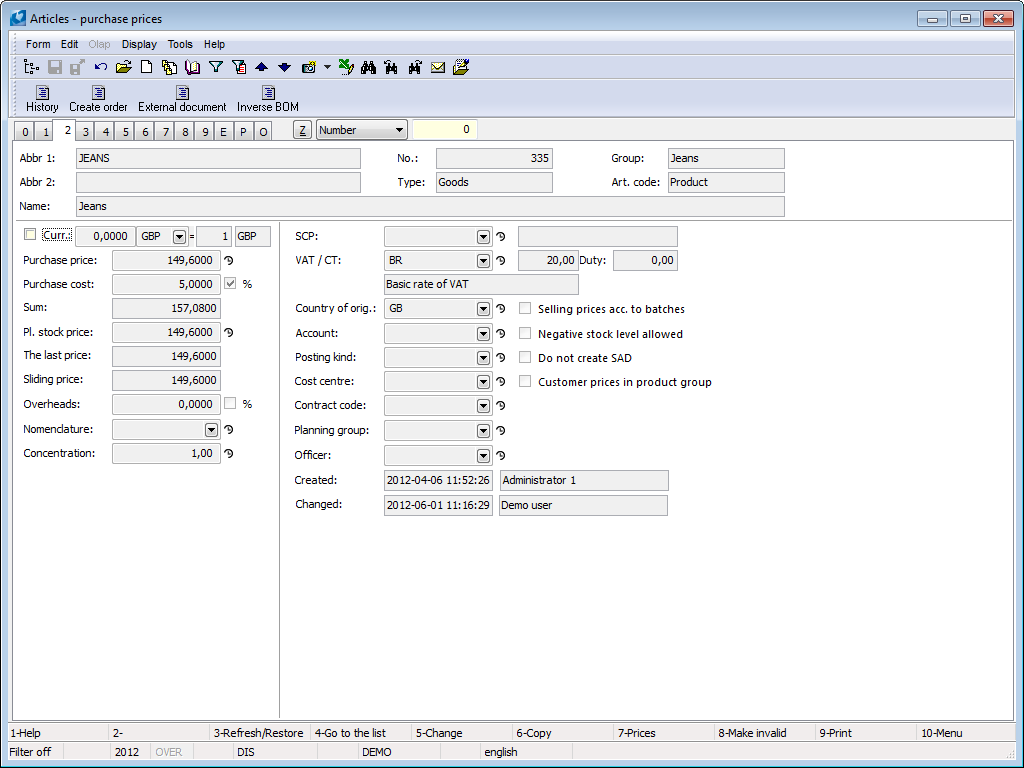
Picture: Article card - 2nd page
Description of the fields on the 2nd page of Article card is defined in the User Guide of the K2 IS.
The purchase price, purchase cost, planned stock price and amount of overheads are defined there.
The meaning of purchase prices in the K2 IS:
There are several variants of setting the stock price in the purchase documents. The ideal case occurs if you have a confirmed Invoice to a received article firstly. This price from the Invoice is also the price of a receipt on a stock (the price in the S field on the item of a receipt card).
If any of the items of a receipt card are not on a confirmed Invoice, it means the Invoice price is not determined exactly, the Planned stock price from the Article card is entered into the stock price of the item. This entered price can be edited. In case that you confirm a Receipt Card earlier than an Invoice, the system notifies you and the receipt will be executed in a price that is defined in the S field on a Receipt card item. Then the Invoice price will be saved only in the Invoice and it does not change the Stock price of the Receipt card any more. In this case, the stock price on a Receipt card will be edited later when Stock Recalculation. It can be run from the initial menu from the Module - Administrator - Recalculations - Stock Recalculation menu.
Pl. stock price from an Article card will be used in the Purchase documents if the price of the receipt article is not defined by the price from an Invoice In. Further this price is used when pricing products by fixed prices.
The price defined in the Purchase price field is automatically entered into a price of an Order (the O field (Net price/UM) on a purchase item) and into an Invoice price (the I field (Net price/UM) on a purchase item). If the Give the last price in purchase option is activated in the User Parameters, then the price from the Last price field is entered into the Order, it means the price from the last confirmed Invoice In. In the case, that the Supplier price lists are defined, the price defined in the Purchase price field is not entered into a price of Order (the O and I fields).
In the event that you want to include the acquisition incidental costs in the article stock price, enter the actual amount of those costs into the C field (Net price / UM) on the purchase item. After executing the Stock Recalculation, these incidental costs are projected into the stock price. (It is necessary to activate the Stock price with secondary costs option in the Client Parameters).
The Planned Secondary costs that relate to the acquisition of articles and that are defined in the Purchase Costs on the Article card, will be inserted into the Purchase item into the C (Net price/UM) field in the case that the Stock price with secondary costs Client Parameter is activated. In the case when you allocate the real incidental costs into the Purchase item by means of the Allocation of Incidental Costs function, the value, that has been inserted from the Article card, will be deleted.
On the Article card there are lots of fields or columns that are necessary to be updated by means of recalculation.
The Sliding price filed is calculated as a current contribution of a value of Article on a stock and an amount on the stock. You can also update it by the Stock Recalculation function.
When pricing the stock by prices according to batches, the Sliding price field has no importance.
Example
A firm that prices with the sliding price has done the following stock movements:
1st February |
receipt |
1 pc |
per 5 EUR |
15th February |
receipt |
1 pc |
per 4 EUR |
16th February |
release |
2 pc |
per X EUR |
28th February |
receipt |
1 pc |
per 3 EUR |
10th March |
receipt |
1 pc |
per 6 EUR |
20th March |
release |
1 pc |
per Y EUR |
30th March |
receipt |
1 pc |
per 5 EUR |
By which price will be priced the releases from 16th February and 20th March and which will be the sliding price to the 31st March?
Solution:
The Release price of 16th February:
2 pcs are currently in the stock, 1 pc per 5 EUR and 1 pc per 4 EUR, it means the release price is calculated as (1pc * 5 EUR + 1 pc * 4 EUR)/2pcs = 4.5 EUR.
The Release price of 20th March:
2 pcs are currently in the stock, 1 pc per 3 EUR and 1 pc per 6 EUR, it means the release price is calculated as (1pc * 3 EUR + 1 pc * 6 EUR)/2pcs = 4.5EUR. There is also the 1 pc on the stock that is priced by a sliding price that is 4.5 EUR.
The sliding price to 31st March:
On the stock there are 2 pcs of articles, 1 pc per 4.5 EUR and 1 pc per 5 EUR. The sliding price is also (1 pc*4.5 EUR + 1 pc*5 EUR)/2 = 4.75 EUR.
It is necessary to know that the Planned stock price on the 2nd page of the Article card does not have to correspond with a stock price on a purchase item and a stock card.
A Planned stock price on the 2nd page of Article card can be updated by the Recalculate stock prices function. You can run this function either over a specific Article (i.e. over the 1st - 9th page of this Article card) or on Articles container from the Action - Stock price recalculation module menu.
It is necessary to update it regularly in the case when you use the stock price to define the selling price (see the Margin chapter).
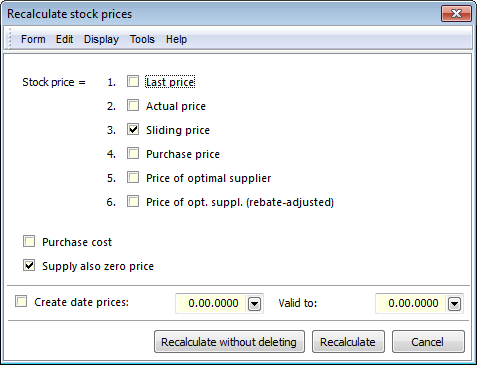
Picture: The Recalculate stock prices form
By means of the recalculation, the stock price is updated according to the last, a current, a sliding, a purchase price, a price of an optimal supplier or a net price of an optimal supplier, some of which of these values are displayed in the fields on the 2nd page of an Article card. The detailed description of this function is stated in the Basic manual in theForm - Actions - Articles chapter.
Example: You will buy a men's leather briefcase. Insert a new card for this article firstly. The supposed purchase price is 300 EUR. The incidental purchase costs are not supposed. The stock price will be also 300 EUR. Issue an Order for this article on the 300 EUR. Invoiced and Stock price is automatically predefined on 300 EUR.
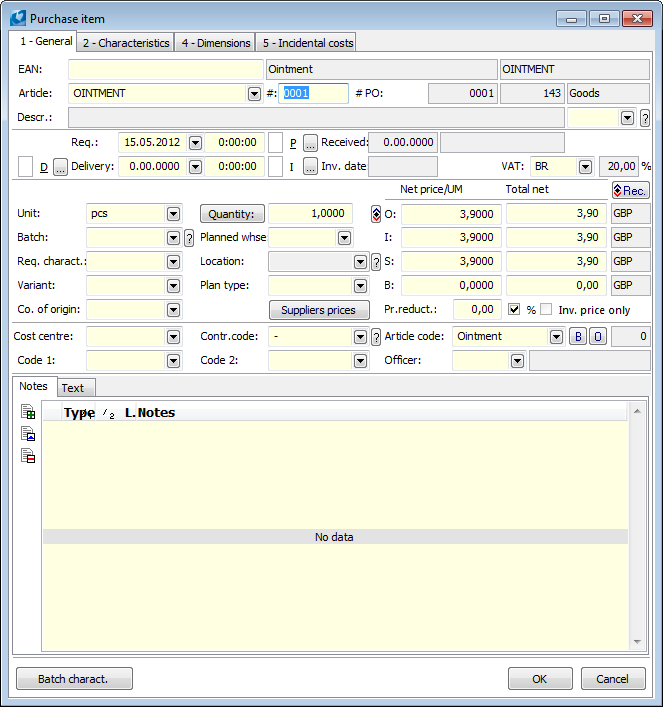
Picture: Purchase Order - Purchase item form
- The article will be received on the stock just before delivery the invoice. When confirmation the Receipt card, you will be asked whether you really want to confirm the Receipt card without a confirmed Invoice. Select Yes. The Briefcase is received on the stock in the price of 300 EUR.
- On the Invoice from supplier, the price will be 350 EUR per the Briefcase. Create an Invoice in the K2 IS, edit the F price and confirm the invoice.
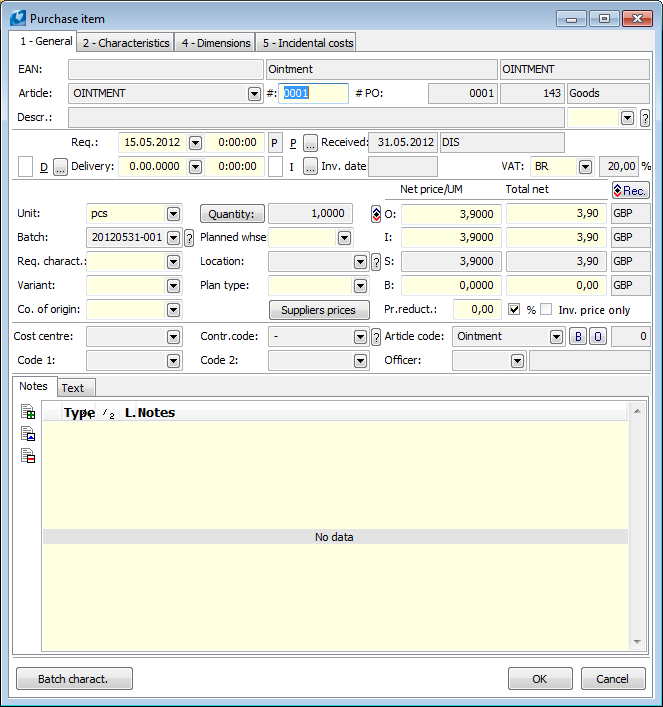
Picture: Invoice In - Purchase item form
- Switch on the 2nd page on the Article card to find out the changes in individual fields.
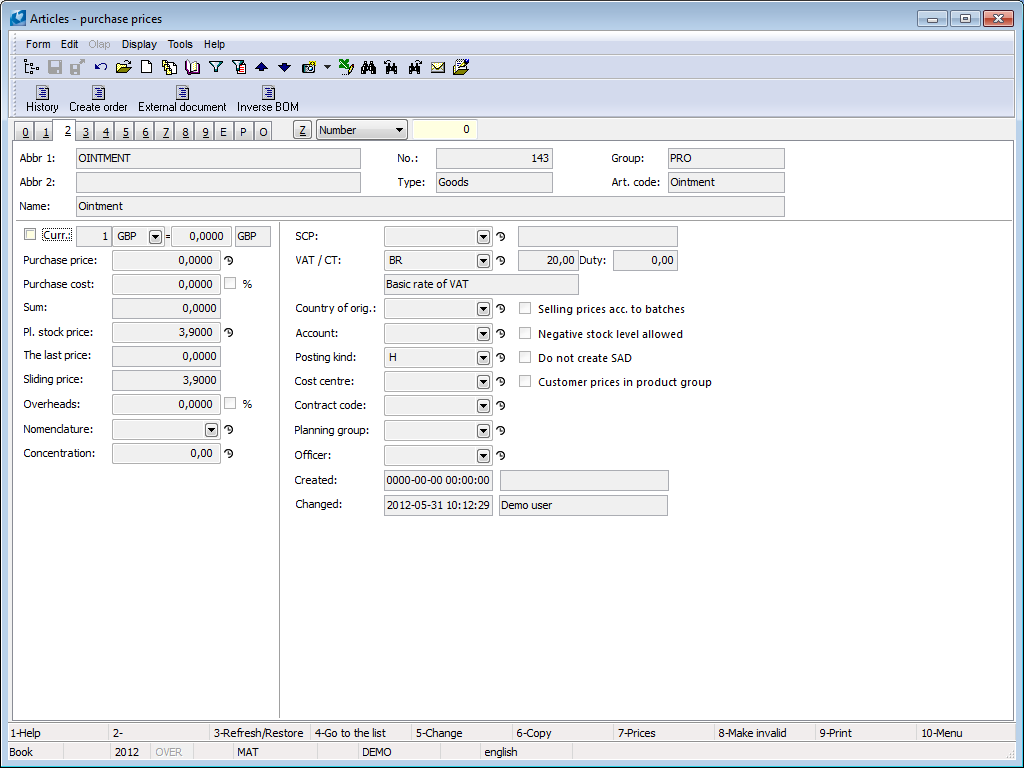
Picture: Article - purchase prices card - 2nd page
The Planned stock price has not been altered. The Last price is the price from the confirmed invoice. The Sliding price is calculated according the price in the Receipt card.
Neither the stock price has been changed in the Purchase item. Execute the Stock recalculation. It is necessary, to this stock price match the reality.

Picture: The Purchase item form after Stock Recalculation
The recalculation has updated the Sliding price on the Article card.
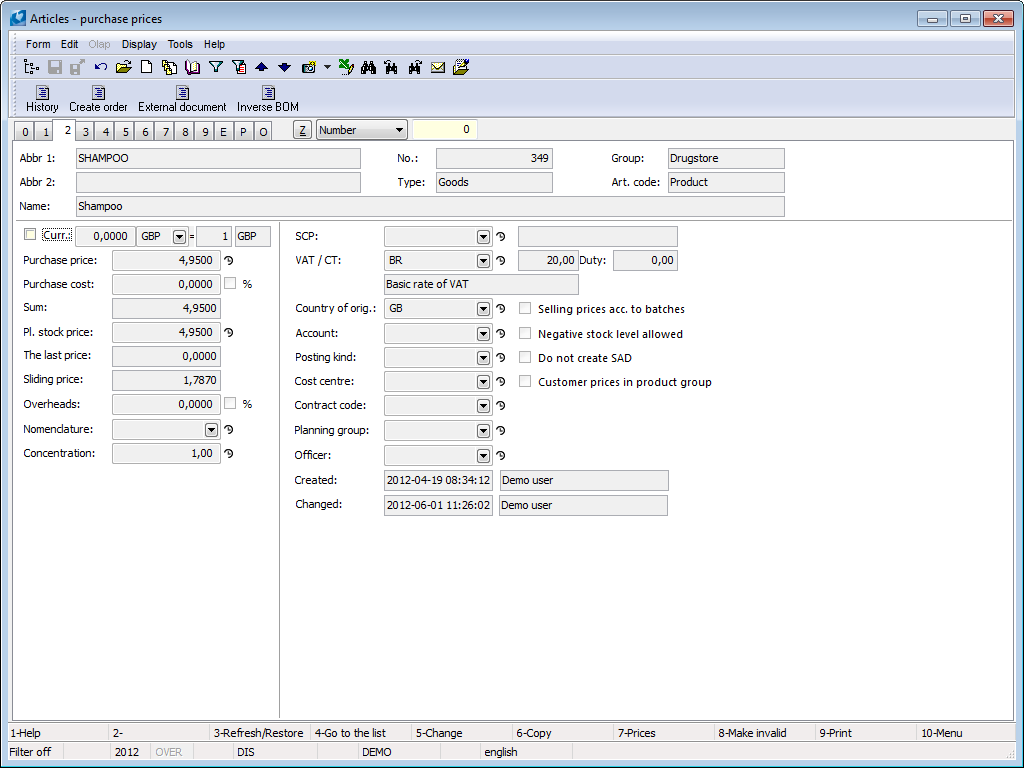
Picture: The Article card - 2nd page - after Stock recalculation
If you want to set the price as a Planned stock price, use the Stock price recalculation function. Run the Recalculation in the Browse mode of the Article card for the Briefcase from the Action - Stock price recalculation.
Supplier prices
The supplier prices enable to record the fixed prices contracted with the concrete suppliers. These prices are automatically filled in the Purchase item if you select the article and supplier who correspond to the entered definition of a supplier price. You can suppress the use of supplier prices by the user parameter Do not use supplier prices.
Defining supplier prices in IS K2 is used, when your business partner delivers the article in system of fixed prices and their adjustments by product groups and multipliers as well as its own article codes. Supplier price is valid for the currency, for which it is defined.
Supplier prices are recorded on the 4th page of the Article card or on the 5th page of the Suppl./Cust. card. (eventually on the 8th page of Suppl./Cust. card are define Supplier date price).
When you add the supplier prices on the 4th page of the Article card, these prices display on the 5th page of Suppl./Cust. card. Also, if we define the supplier prices on the 5th page of the card Suppl./Cust., then these prices appear on the 4th card of Article.
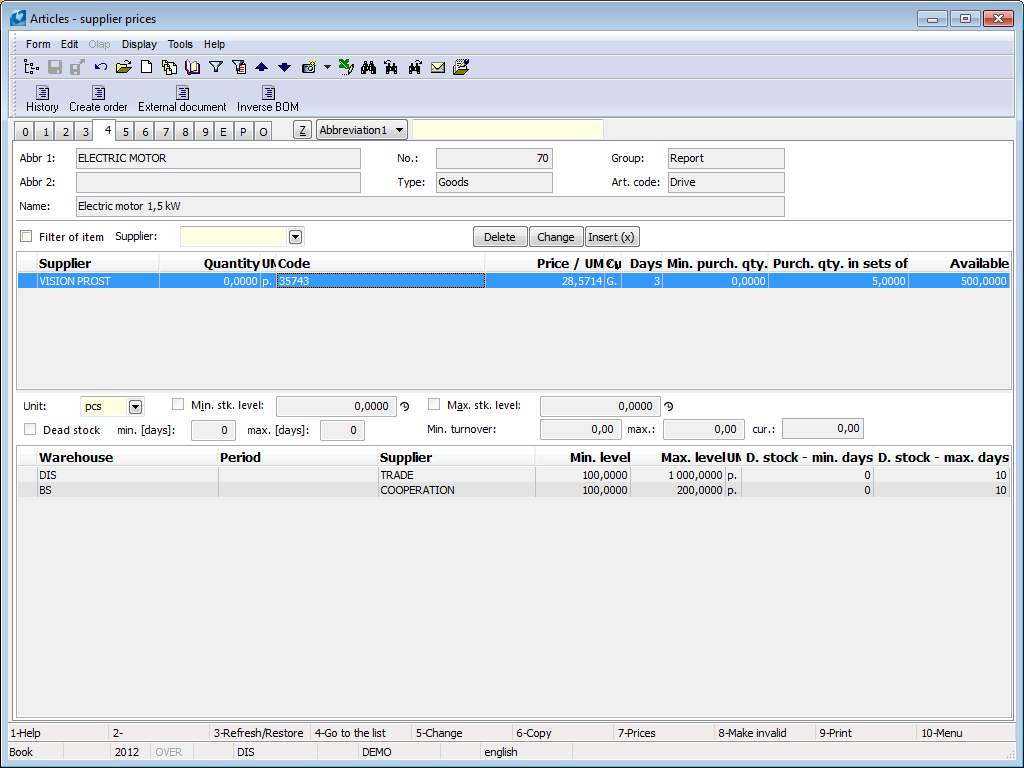
Picture: Article card - 4th page
This page of Article card is accessible in Change mode and in New record mode. Press Ins key or press button Insert to define new supplier prices in card through a form Supplier prices.
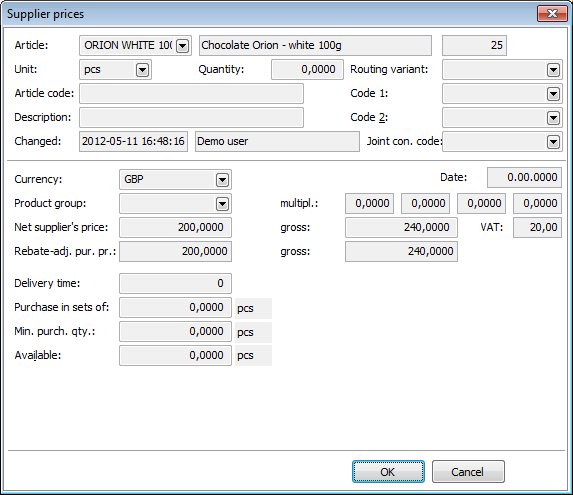
Picture: Form Supplier prices - 4th page of Article card
Descriptions of the individual fields of the Supplier prices form are stated in the IS K2 Basic guide.
Individual fields are filled by data obtained from the supplier. Supplying product group is always assigned to a specific supplier. You select the product group from the Supplier product group's table menu. Here you can define a new product group by pressing F6 key (or Ins) or change (including multiplier values) whichever group by F5 key. Within the product group you can set the values of multipliers and rounding, which will be applied to the calculation of the net purchase price.
Multiplier means a figure that provides the possibility to take into consideration various variances of supplier prices (discounts,... - multiplier <1; transport, surcharges >1 etc.). For each product group, you can specify four such factors that are further reflected in the net purchase price of articles simply by multiplying all coefficients and a specified price. For example if you select one multiplier = 0.5, and you do not select the others, then, when defining the price 100 EUR, the final Rebate-adjusted purchase price will be equal to 100 x 0,5 = 50 EUR.
Over an Article card/book you can run the Supplier prices overview report. This report displays prices overview that is defined for individual suppliers.
Example: You have an purchase order to the supplier, for which you have defined supplier prices. The purchase order is in currency EUR, but supplier prices are defined in currency USD.
In the purchase order will be not achieved supplier prices, because price currency is not the same with currency on the document. In this case, the price of an order substituting the price indicated in the field Purchase price from article card (if is entered). If you want to replace supplier prices for currency USD, must also be defined in this currency.
On the Supplier card the entering supplier prices is very similar, only instead of selection of a supplier you select an article for that this price is valid. The prices that are entered by this way are displayed in consequence on an Article card as well.
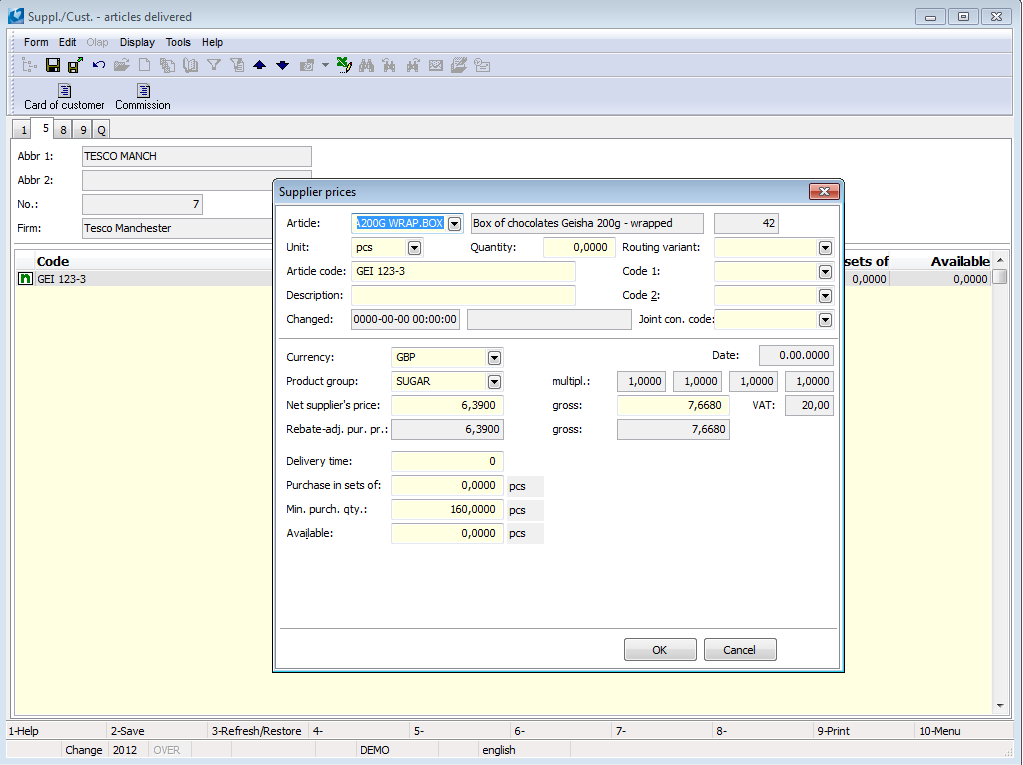
Picture: The Supplier prices form of a Supplier card
Selling Prices
Selling prices can be entered using Price Lists (they must be activated in the Configure Price Lists) or in the original way. The description of Price lists is stated in the chapter Sale / Basic data / Price lists. The following chapters deal with setting the selling prices in the original way.
We have several means at selling prices that allow us to merge our customers into groups and correctly evaluate their sales orders according to their classification or contracts. Customer prices are the prices of certain groups of articles for specific customers (in the picture below the relation no. 3). Customer prices are determined by the direct relationship between the articles and the customer (relationship No. 4 in the picture).
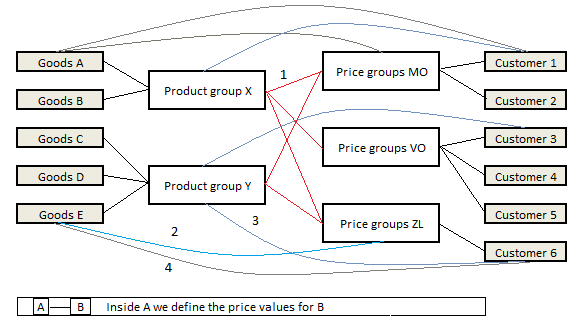
Picture: Price creation options
Especially the Margin, Product groups, Price groups are important for company's selling pricing policy. The various parameters and flags offer further possibilities.
A selling price can be defined as the sum of purchase costs and a surcharge. The Surcharge can be set either in absolute amount or percentage of purchase costs. Next to the surcharge term the Margin that is determined as the difference between selling price and purchase costs, eventually as a proportion between selling price and purchase costs of the Articles, is further defined.
Note: The K2 IS does not work with the surcharge term, but it uses the margin from above or from below. Therefore, the Margin term will be used in further interpretation.
Margin can be set either in absolute amount or percentage. You can insert new margin into a code list as standard by Ins or F6 key.
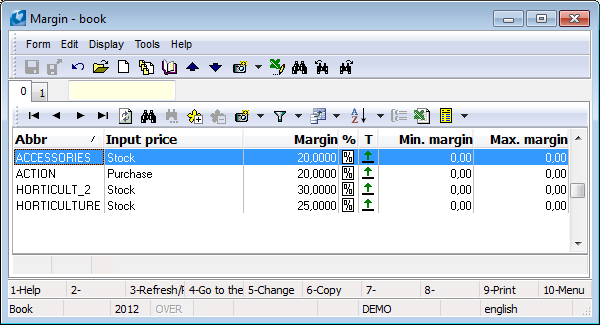
Picture: Margin form - 1st page
Descriptions of the individual fields are stated in the K2 IS Basic guide.
An input price is a basic price which corresponds to the calculation of a selling price. In the menu the Purchase price, Rebate-adjusted purchase price, Supplier price, Sliding price, Last price, Selling price, Stock price or Actual price will be displayed.
Note: In the menu all prices types are displayed, however, not all prices types make sense as a base. E. g. the selling price can not depend on the "selling price" value, therefore this option will not be used.
In the Cust./Suppl. database the customers are divided into the various price levels according to so called Price groups. This enables to add various discounts or surcharges to the members of different price groups.
You insert a new price group by Ins key or F6 key.
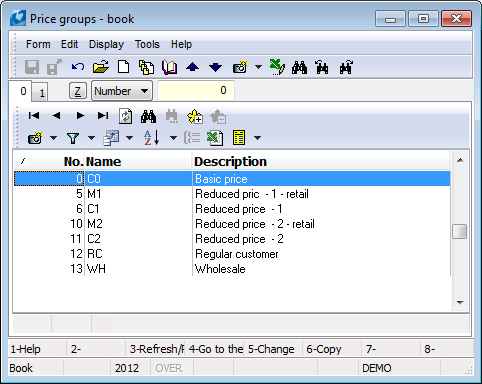
Picture: Code list Price groups
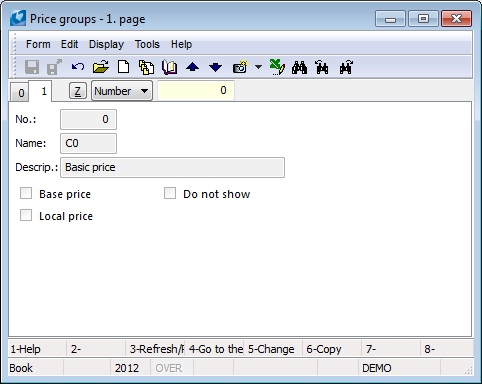
Picture: Price groups - 1st page
Descriptions of the individual fields are stated in the K2 IS Basic guide.
To enter the optimal number of price group it must be considered to whether these groups are sorted and it is worked with their grading or you can set them randomly. This influences the usage of the Unsorted price groups' parameter in the Client parameters. This parameter influences the process when entering the selling price in that case that the price will not be defined directly for a selected price group.
Example: The product Phone exists and the defined price is only for M1 and M2 groups (see the picture above: Code list Price groups). The Phone you want to sell to a customer that has the C1 group. If you switch on the Unsorted price groups parameter, then, if the price for C1 group will not be found, the basic - catalogue price will be automatically entered. If you switch off the parameter, the price with the next lower number will be entered, also the price of the M1 group.
Product groups divide the Article database into the groups, whose function is identical in terms of the Price Creation.
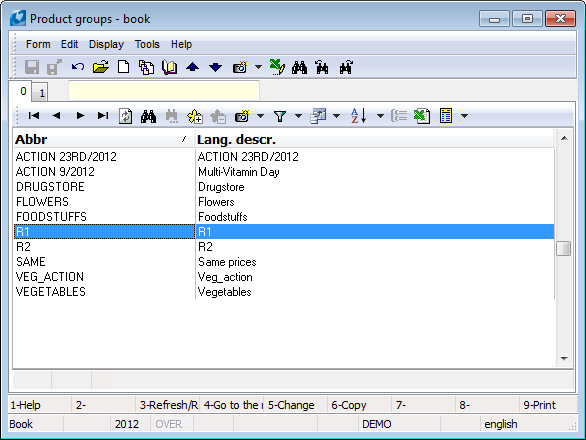
Picture: The Product groups menu table
A product group is inserted in the menu table by Ins or F6 key. The deletion of a product group from the menu table is not possible.
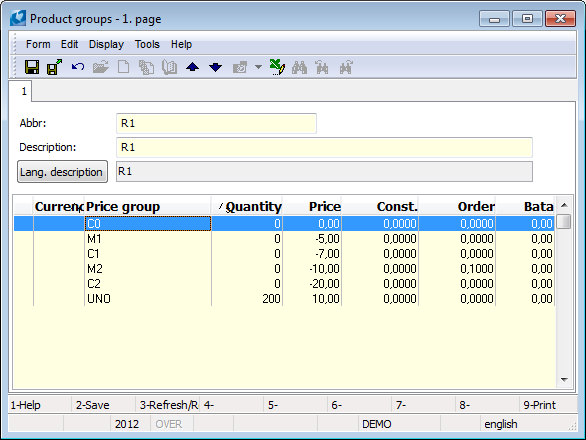
Picture: The Product groups - 1st page
Discounts for the price groups or for the concrete customers you define by the product groups items that are entered on the 1st page by Ins key.
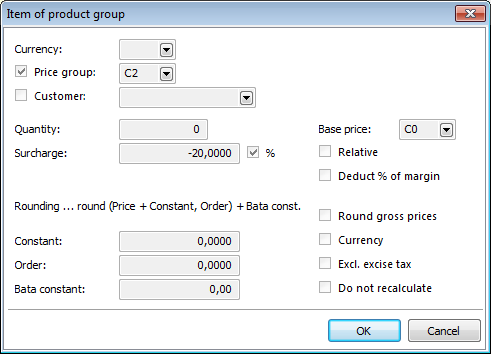
Picture: The Product group item form
Descriptions of the individual fields of the Product group item form are stated in the K2 IS Basic guide.
For deleting a product group item you use Del key in the Change mode.
In case of batch records you can select the Selling price acc. to batch possibility on the 2nd page of an Article card. Likewise, the Customer price in product group flag, which reduces the number of records in the selling prices on the Suppl./Cust. card, can be changed here and the price will be quantified in case of usage according to the product group definition.
In the User parameters you can set if you want to insert the price according to the main customer or addressee (Customer Prices according to Addressee) into a Sales order, if the user uses the supplier prices or whether it is always based on the basic selling price (Do not use supplier prices). Further you can suppress here display of a stock and catalogue price in a selling item (Show catalogue (price list) price and Do not display stock prices in sale). Next you can choose if you want to copy the price group into the items from a document header or from a previous item (Price group on item from heading). If you choose the copy from a document header, you can still specify if you want to keep the original price group or to enter a final price group to the item (Insert the resulting price group). If you switch the parameter on, it can happen that the Price group field in a Selling item will be empty - the Supplier or Customer price, eventually the price directly inserted into the Selling item is reflected in this way.
You can now imagine the picture from the beginning the Selling prices chapter a little more specifically - in the picture on the Demo data of K2: The link 1 determines the price of a group of Articles cards (product groups) for group of Customers (price groups). The link 2 appreciates a concrete Article card for Customers groups. Contrarily, the link 3 determines the price of group of Articles for a particular Customer. The Price of an Article card is determined by the last relation for a one particular Customer. The last possibility is left - the price directly inserted into the Selling item. This possibility is uninteresting concerning to automated price creation.
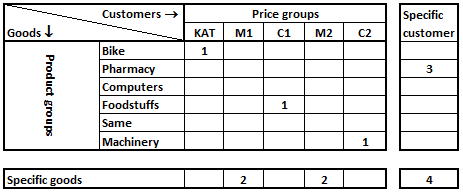
Picture: Price creation in the Demo data
The icons are displayed in the Selling item next to the Price group field. Both of these elements facilitate orientation in the way the price was determined. A general description of these icons is given in the K2 IS Basic Guide. Here are stated a few specific examples.
The completed prices group, without the icons |
The price is defined by the product group for the price group. |
|
The price is defined by the product group for the concrete customer. |
The completed price group, |
For a given product group, the customer has assigned a different price group than the own from Article card. That means The price in the product group is defined in that way a different price group is the basic price, the price is not further adjusted. |
|
The price is inserted to the concrete Article card for this customer . |
|
The price is inserted directly in the Selling item. |
If the new price lists are not activated (for more details see Sale / Basic Data / Price Lists), then on the 5th page of the Articles card we define both permanent and date selling prices of the selected article.
At the upper part of the screen is the header of the selected article, in the middle you can define selling and date prices. At the bottom of the screen, there is a list of prices for each customer or price group corresponding to the selling or date price, on which the light indicator in the central part of the screen is placed.
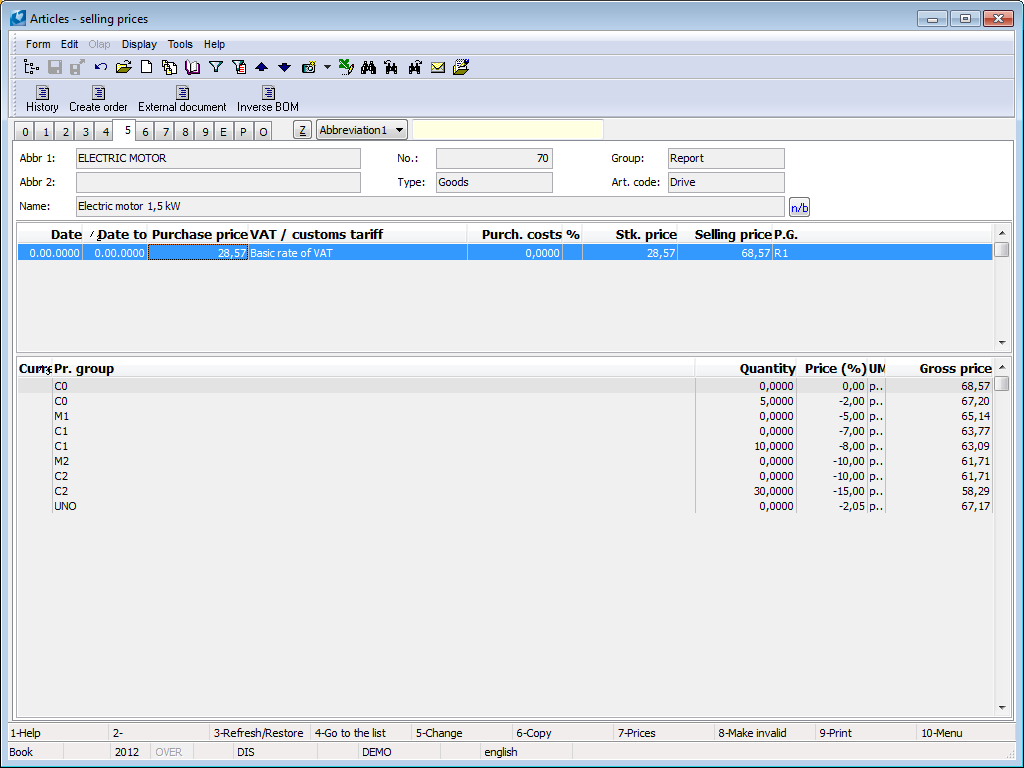
Picture: Article card - 5th page
By pressing Ins key in the Change mode in the middle part of the screen you display the Price list preparation form. On the 1st row the basic selling price is defined, on the next rows the date prices are defined.
In the Price list preparation form an appropriate margin (eventually a selling price) and a product group is selected.
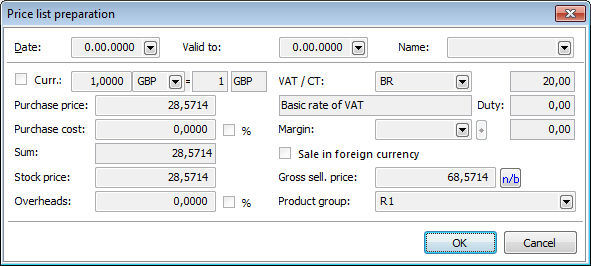
Picture: The Price list preparation form - 5th page of an Article card
Descriptions of the individual fields of the Price list preparation form are stated in theK2 IS Basic guide.
After a change in the Margin field the user is asked if the selling price on this form shall be recalculated. Similarly the user is asked after leaving the Product group field and closing the form, whether he wants to recalculate the price groups. To the lower part of the 5th page of an Article card the price for the prices groups that are defined within the product group will be inserted after recalculating, if the Customer prices in product group option is not checked on the Article card. In that case the prices will not display in the lower part. The price will be quantified directly when this price should be used in sale according to its definition. The advantage is especially the overview on the 7th page of a Supplier/Customer card where the price defined by a product group are in different part and the price defined by the relation of a Customer - an Article are in different part.
The final sales price resulting from this form is called Basic selling price. The selling price is inserted while creating new items in the sale as a Catalogue price. An user can neither influence nor recalculate in consequence the value of this price. If is on the form checked the option Sale in foreign currency and currency of document is identical, then is transferred to the document the Catalogue price. If the currency of selling price will be other than on the document, transfer Catalogue price in the client currency and subsequently recalculate exchange rate on the document.
In the lower part of 5th page of Article card there are displayed data that relate to price groups setting, alternatively to customer prices. The prices you can set by two ways:
- by inserting the Product group field in a previous form and by selection of a price group recalculation these price will be automatically inserted,
- By pressing Ins key you display the Article prices form where we can set the appropriate data.
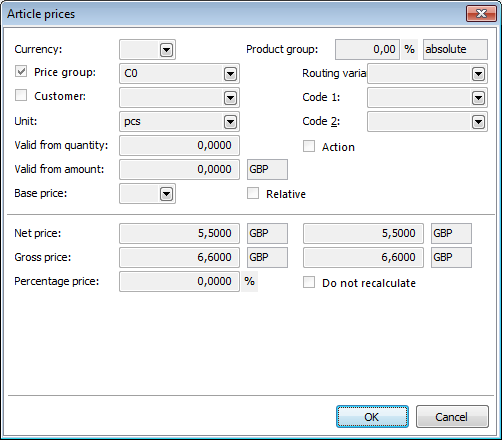
Picture: The Price list preparation form - 5th page of an Article card
Descriptions of the individual fields of the Article prices form are stated in the K2 IS Basic guide.
The selling price can be browsed in a several ways:
- 5th page of the Article card - the prices are defined here, also the statement is completed.
- the Article table - F7 function - displays only the common selling prices, that means the date prices are not taken into consideration
- the Article book - Article prices subview window - the price will be displayed that would be displayed in the document at the moment, that means the date prices too if they are valid in that moment.
- The Price list of the article report - the defined prices of the selected Article cards are printed.
- The Price list of the article for the customer report - for a selected customer the prices are printed, which would entitled the customer to, including how the price was set (a price type).
The Customer price is the selling price of the articles group or of a concrete group that is defined for a concrete customer.
Customer prices are registered on the 5 th page of an Article card or on the 5th page of a Suppl./Cust. card.

Picture: Customer prices - the 7th page of the Suppl./Cust. card
On this page the records are inserted by Delete, Change and Insert buttons in a Browse mode. After pressing Insert or Change button the Product group item, resp. Article customer prices, form will be displayed, in accordance with the part that the light indicator is positioned. In the upper table the customer prices are defined. You insert a new item of a product group. This is an alternative way to create product groups of items from this group, the record is subsequently reflected in both places. The previous chapter is focused on a description and a purpose.
In the lower part of the form all prices that are defined for the customer, or only the customer prices are displayed (depending on the Article characteristic the Customer price in product group).
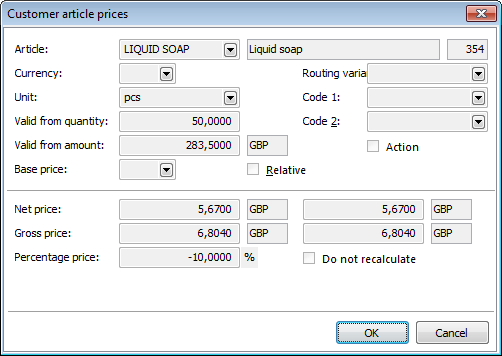
Picture: Customer article prices form
Descriptions of the individual fields of the Customer article prices form are stated in the K2 IS Basic guide.
Example: A company produces and sales two kinds of articles: flowers and vegetables. These articles are sold to the retailers and wholesalers. Retailers and wholesalers can have defined various surcharge for various kind of articles.

Picture: Product and Price Groups
The basic selling price is based on the stock price to which the 25 % margin is added. Flowers and vegetables are sold to ordinary customers at this price. The firm sells to the permanent - registered customers flowers with 5 and vegetables with 12% discount. For wholesale, the price is 12 % lower for flowers and 18 % lower for vegetables.
Solution:
- Create firstly a new margin in the Margin code list. As an Input price define a Stock price, into the margin field type '25' and check the % field.
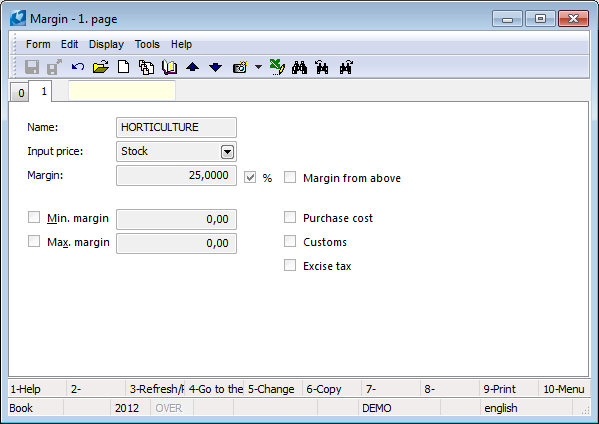
Picture: 'Gardening' margin
- Then define the price groups for wholesalers and the regular customers.
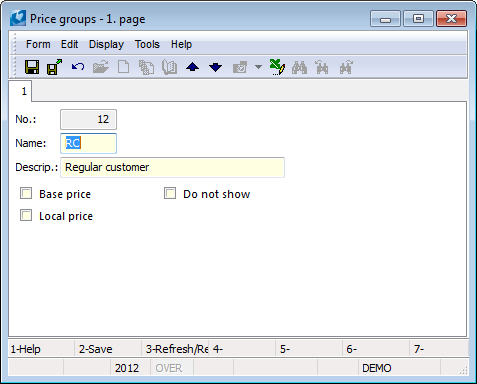
Picture: 'Regular Customer' price group
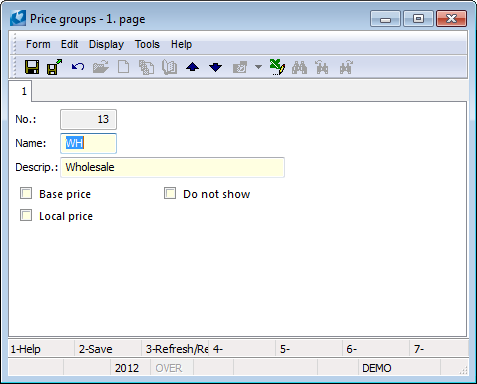
Picture: 'Wholesale' price group
- Create the product groups for flowers and vegetables.
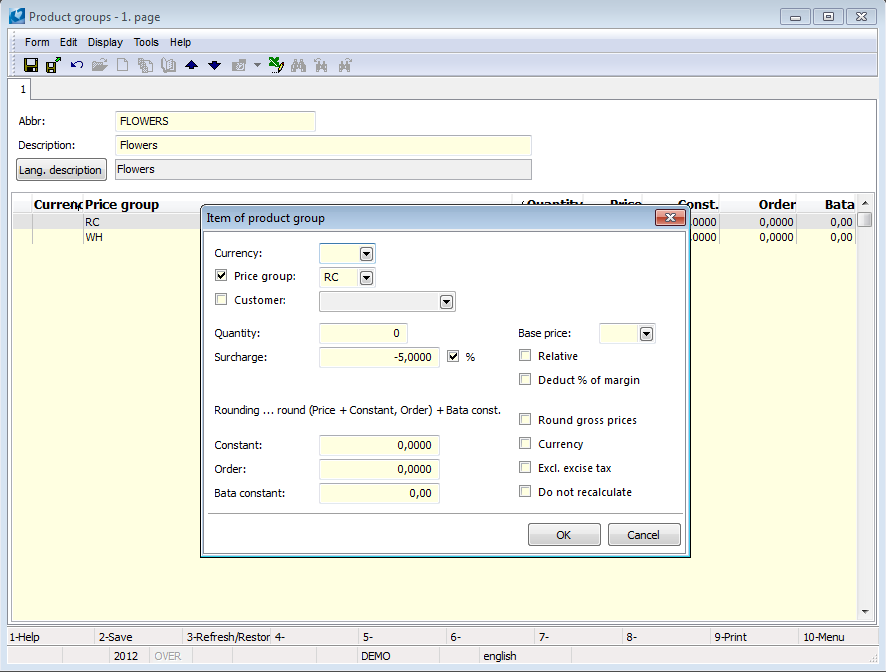
Picture: The Item of product group 'Flowers' form for 'Regular customers'
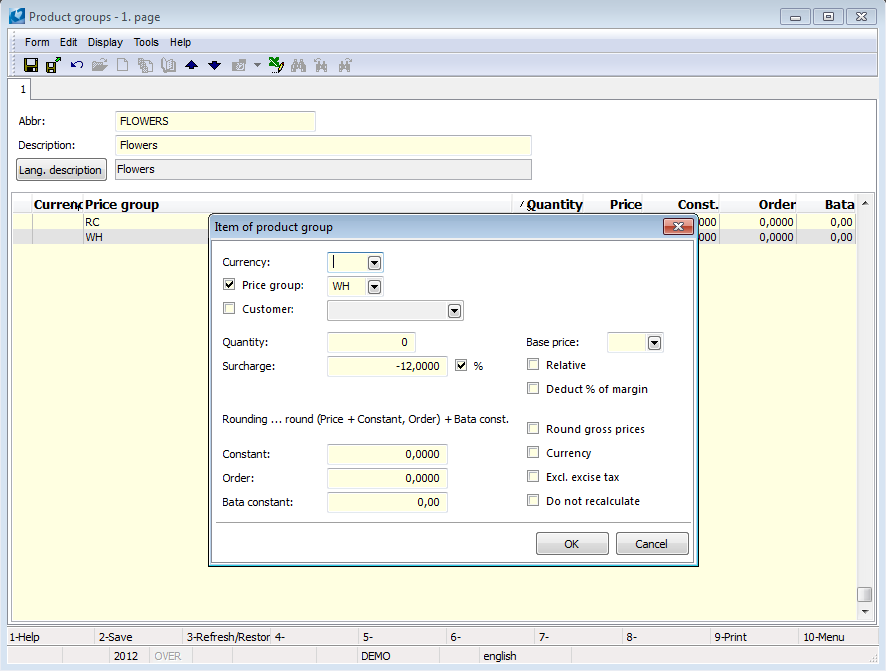
Picture: The Item of product group 'Flowers' form for 'Wholesale'

Picture: The Item of product group 'Vegetables' form for 'Regular customers'
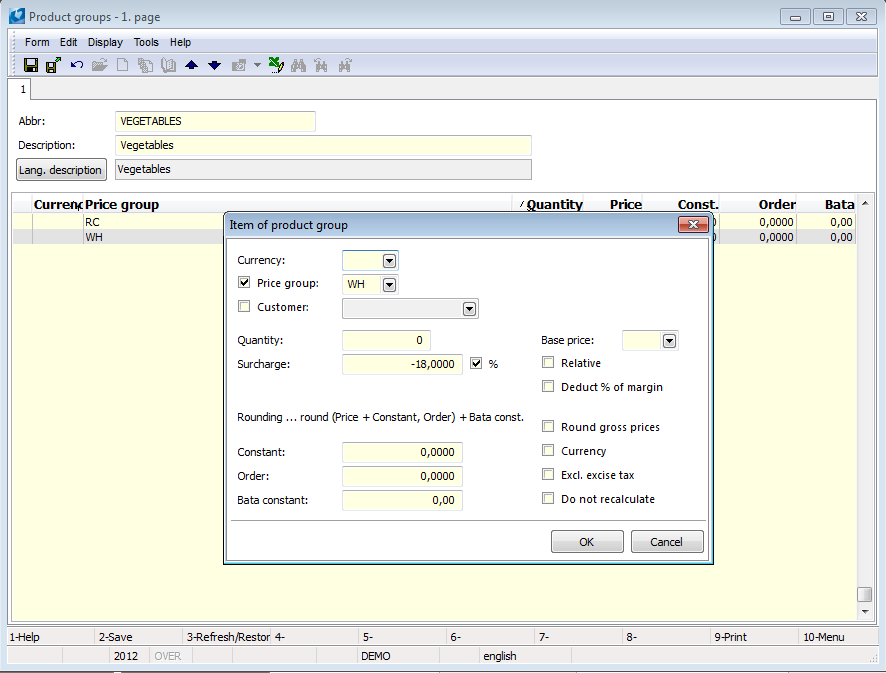
Picture: The Item of product group 'Vegetables' form for 'Wholesale'
- Insert all cards that you want to price as Flowers into the Article filter and run the function from the Form - Bulk Actions - Change record module menu. Enter the 'Gardening' margin and the 'Flowers' product group on the 2nd page of the Bulk change of Articles form.
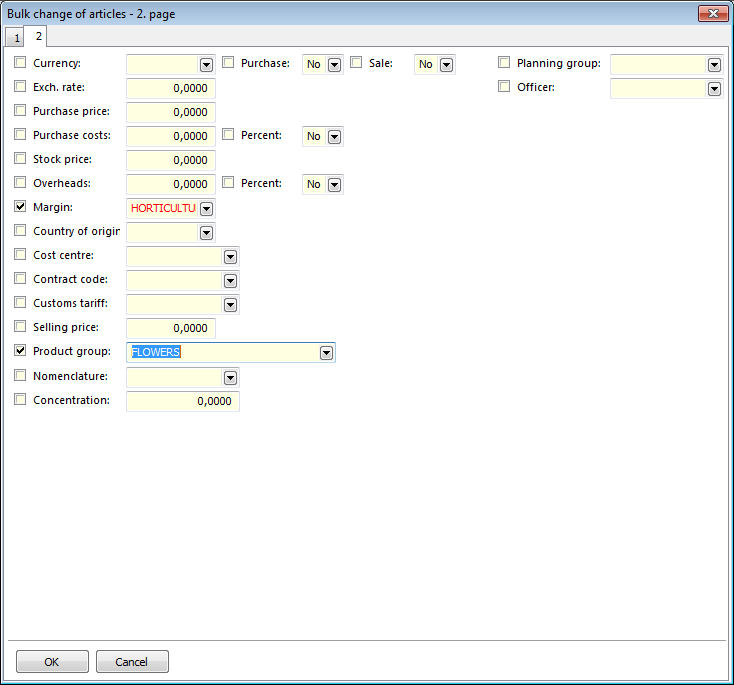
Picture: The Bulk change of articles form - 2nd page
- In the same way fill a margin and a product group into the Articles cards for Vegetables.
- After that run the function from the Actions - Recalculate article prices module menu on the filter of the Article cards for the groups Flowers and Vegetables.
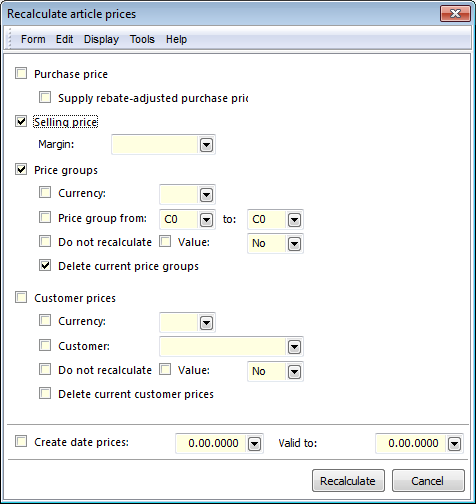
Picture: The Recalculate article prices form
The function calculates a selling price according to a defined margin and a product group on the individual article cards for both price groups.
This function is also used for a regular update of a selling price on an Article card.
After defining the selling prices, you can print the Article price list in the K2 IS. Print the Article price list report on the filter of Articles card for flowers and vegetables.
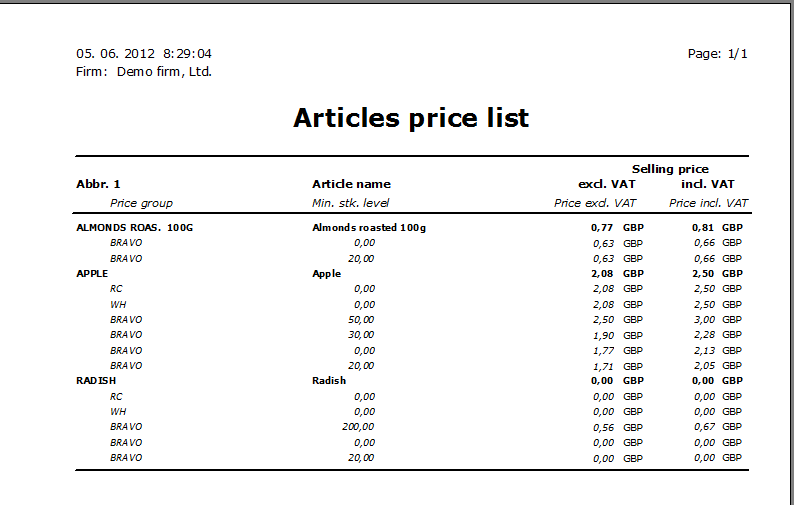
Picture: The Article price list report
Selling prices, that are defined on the 5th page of the Article card, are displayed in the report. It means an input price adjusted for margin or the directly defined selling price.
If you want to display also the prices that have been adjusted according to a defined surcharge (discount) for the selected price group or for the supplier in the price list, print the Price list for Customer report over the selected customer or over the filter of customers.

Picture: The Price list for Customer report
The selling prices for the particular customer are displayed in the report. Category of prices (e.g. Catalogue, Supplier - a price group is displayed) displays a way how the result price has been determined.
Date prices are not taken into account in the reports.
Example: The company agreed to its biggest customer (e.g. Bravo Company) the following conditions:
1st The customer will receive a discount of 15 % for flowers. For orders over 50 pieces of the same goods the customer reaches 20 % discount, and over 100 pieces will receive a discount of 25 %.
2nd The customer will receive a discount of 15 % for vegetables. If he takes more than 20 pieces, he reaches 18 % discount.
3rd The goods "Roasted almonds" will be sold to the customer for the selling price Ł 2. When taking 2 pieces the price will be Ł 1.8 per piece.
Solution:
Point 1 and 2 are filled with the customer price. Point 3 means to define a customer price.
Customer price:
In the previous examples we have defined the selling price for flowers equal to a stock price + 25 % margin and the product group "Flowers". Now in this product group next three items will be added three with the customer prices for the Bravo company.
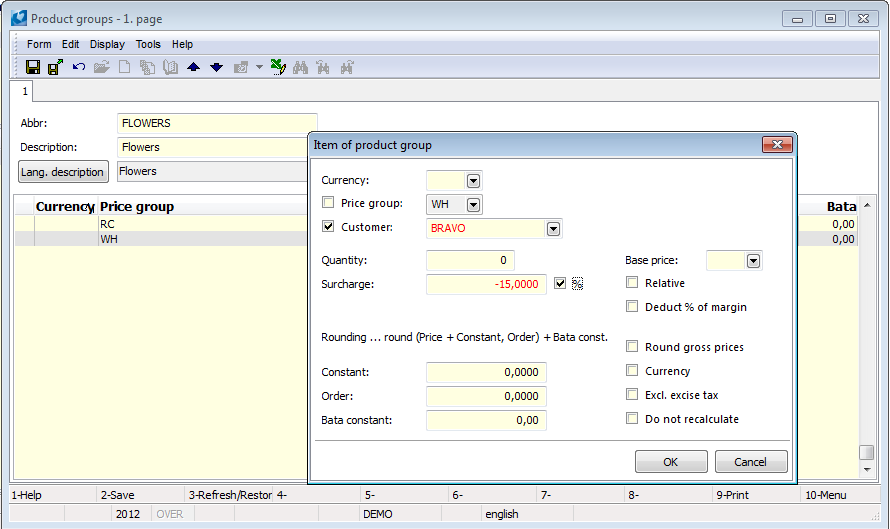
Picture: The Product group item for the customer price for purchase to 50 pieces
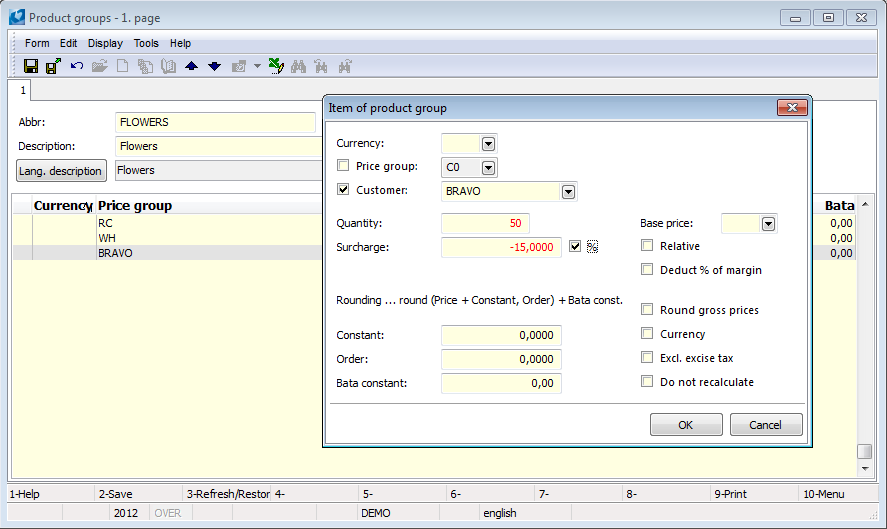
Picture: The Product group item for the customer price for purchase over 50 pieces
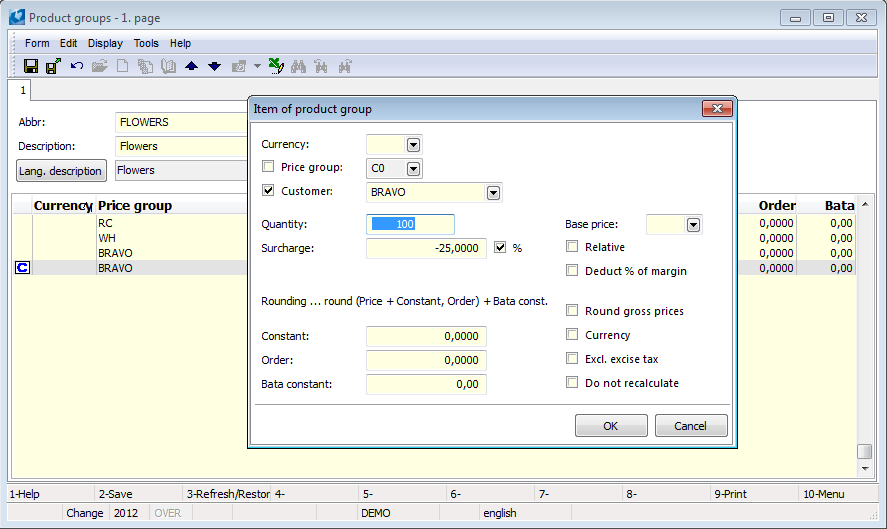
Picture: The Product group item for the customer price for purchase over 100 pieces
Simultaneously you will continue with vegetables. Into the "Vegetables" product group you add next two items for the customer prices.
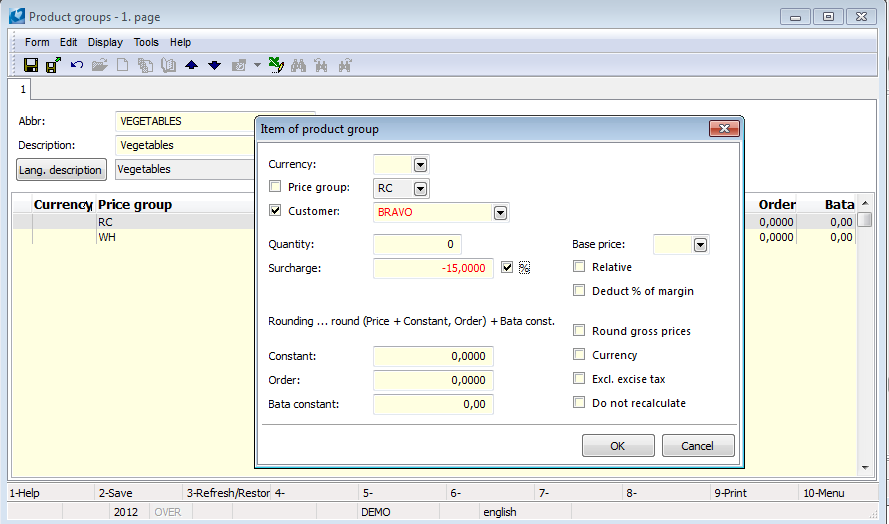
Picture: The Product group item for the customer price for purchase to 20 pieces
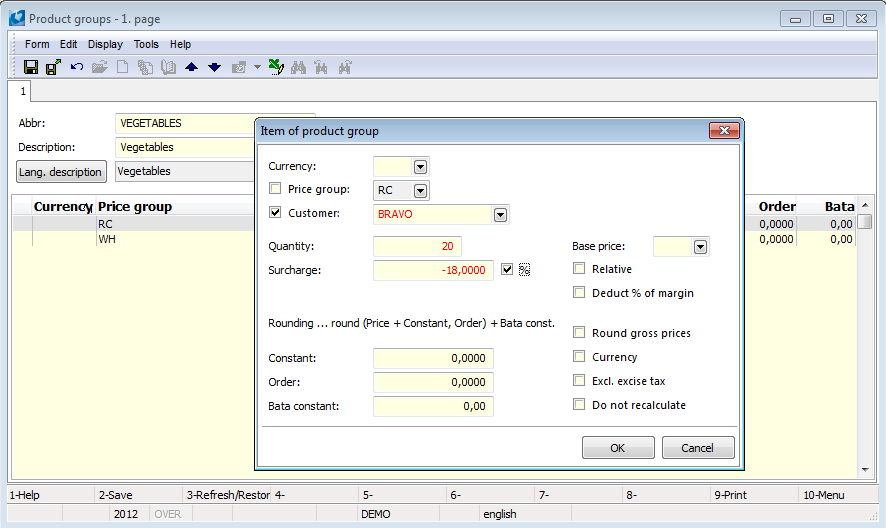
Picture: The Product group item for the customer price for purchase over 20 pieces
Over an Article filter, where the Articles card will be with the "Flowers" or "Vegetables" product group, you execute the Recalculate article prices function and there the Recalculate customer prices function.
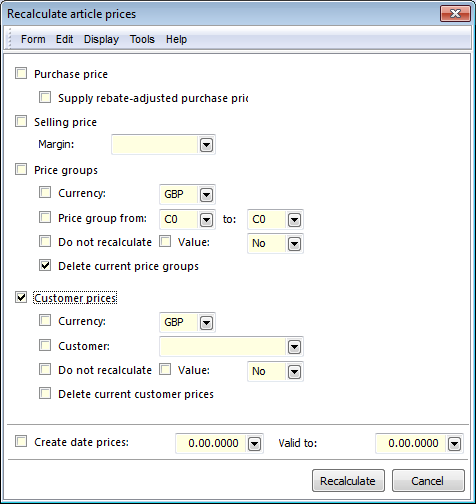
Picture: Recalculate article prices form
The defined prices are displayed on the 7th page of the Suppl./Cust. card. If the Customer price in product group option is checked on an Article card, this article would not have its records in the lower part of the form. When selling articles the definition directly from the price group would use.
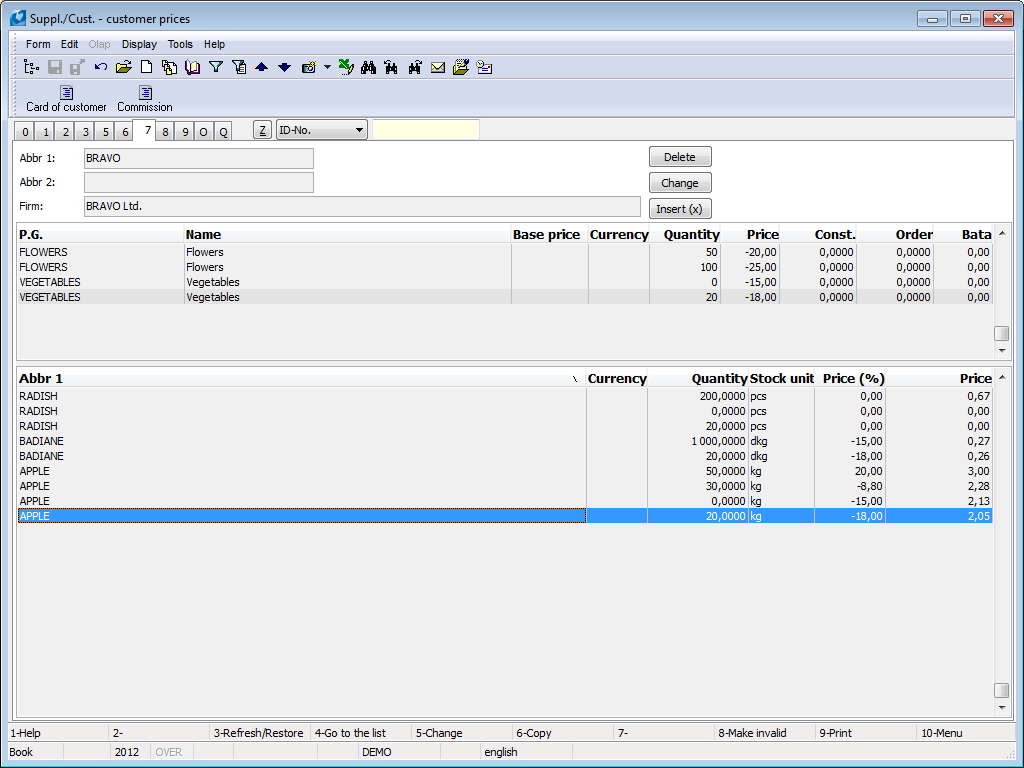
Picture: Suppl./cust. card - 7th page - the Customer prices
Customer price:
Now we have left to define the consumer price of "Roasted almonds". You will enter it on the 7th page of Suppl./Cust. card in the lower part of the screen by the Insert(x) button, the same thing you can do on the 5th page of an Article card in the lower part of the form.
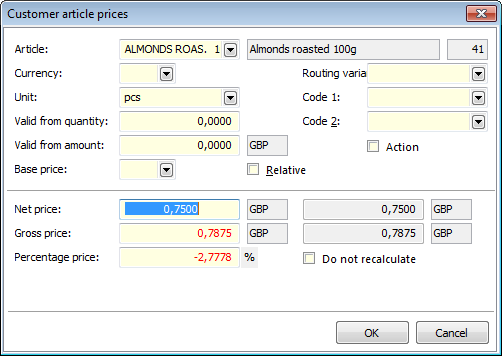
Picture: Customer price of "Roasted almonds" when purchasing to 2 pcs
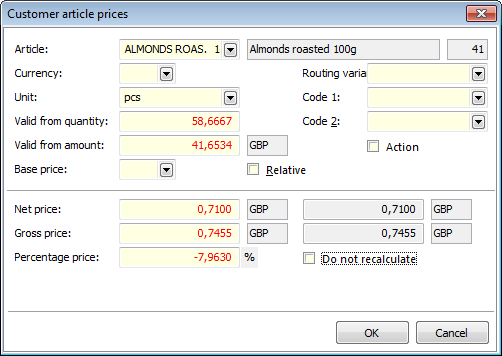
Picture: Customer price of "Roasted almonds" when purchasing 2 pcs and more
The defined prices will be added on the 5th page of Articles card as well.
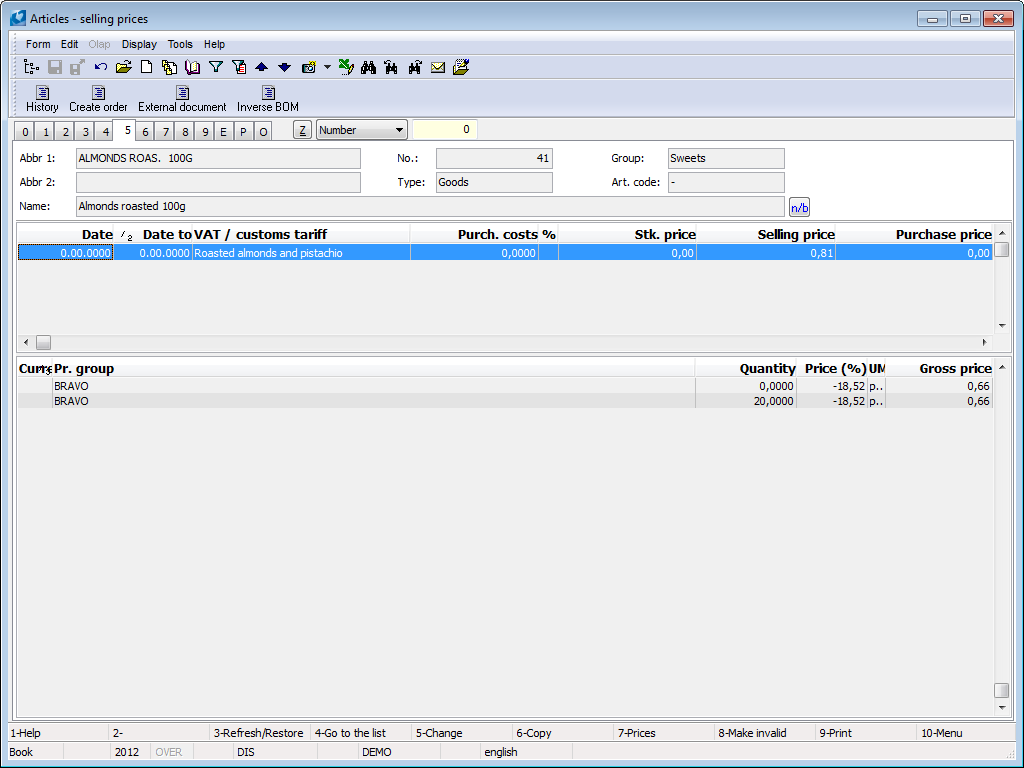
Picture: The Article card - 5th page
Example: The company changes the pricing policy for vegetables. So far, the selling price has been calculated as stock price + 25% margin, the company sells vegetables to steady - registered customers with a 12% discount, for wholesale, the price is 18% lower.
Newly the firm wants to create a selling price with a margin of 30 % to the stock price. The company will then provide a discount of 14 % for wholesalers and 8 % for steady customers.
Solution:
- Define a new margin in the Margin code list. Enter a stock price as an Initial cost, into the Margin field type the value 30 and check the field %. If we do not use the original margin for any other product groups and therefore do not want to keep the margin, it is not necessary to create a new margin, but we can only adjust it. In our case, however, a margin of 25% surcharge remains valid for flowers, so we can not modify it.
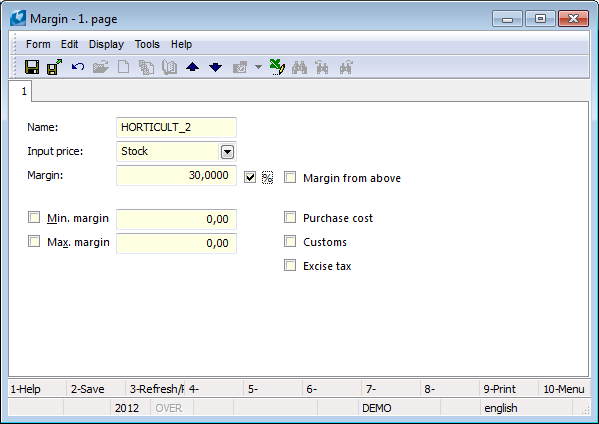
Picture: Margin 'STOCK+30%'
- Search for the 'Vegetable' product group in the Product groups code list. Change percentages of surcharges for the price groups 'VO' and 'SZ' on the 1st page.
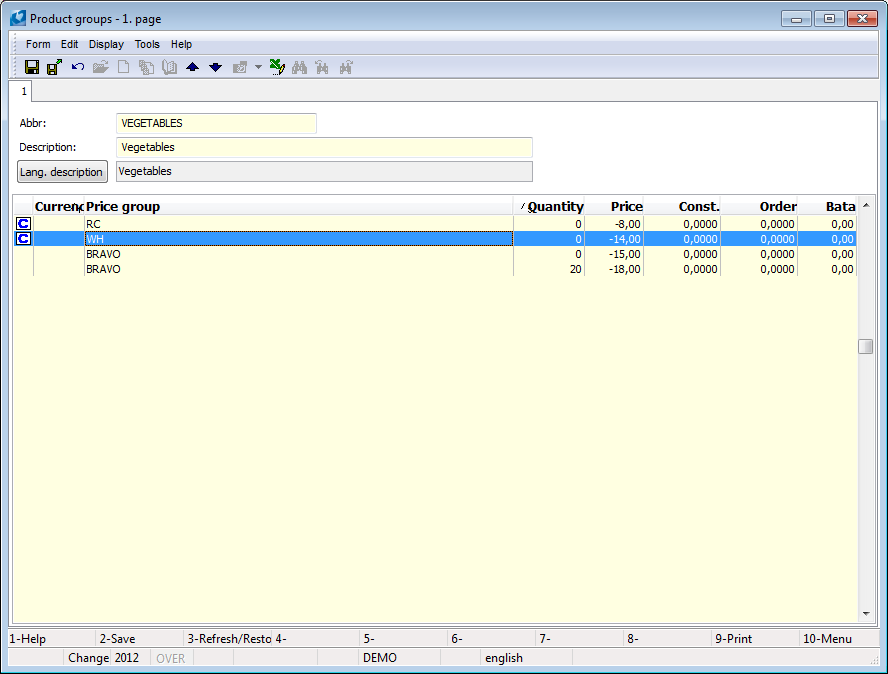
Picture: The edited items of the 'Vegetable' Product group
- Save the 'Vegetable' product group.
- Insert the article cards with the 'Vegetables' product group into the filter, mark the records with asterisks and run the function from the module menu Form - Bulk actions - Change record. Enter the just now created margin on the 2nd page of the Bulk change of articles form. By this way add a new margin into the appropriate Article cards.
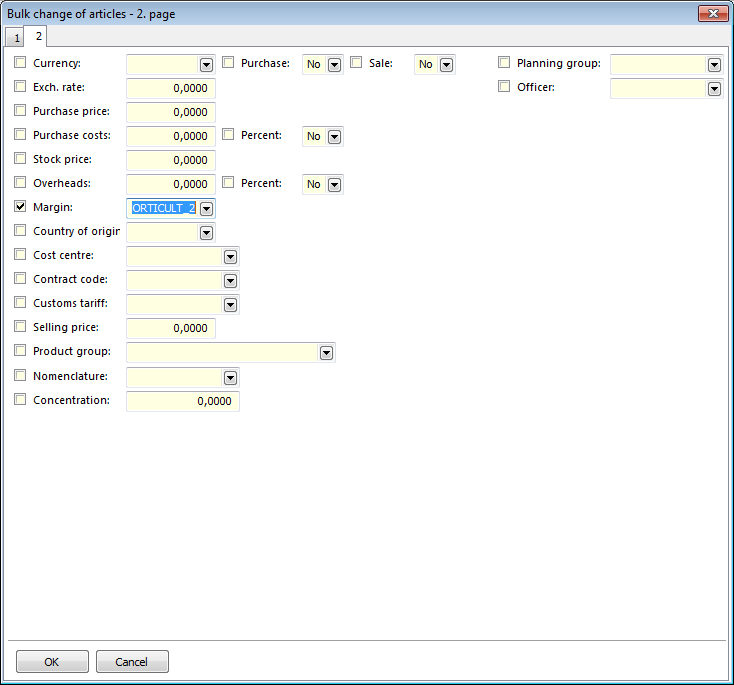
Picture: The Bulk change of articles form
- On the same articles filter run the function from module menu Actions - Recalculate article prices to update a selling price saved on the Articles cards.

Picture: The Recalculate article prices form
Date prices
The Date prices are the next instrument of the pricing policy. There are prices whose are valid at concrete date. Date prices are defined by the same way as selling prices on the 5th page of the Article card with the difference that you enter Date (date from) and Valid to (date to) in the Price list preparation form, that means in which interval is price valid.
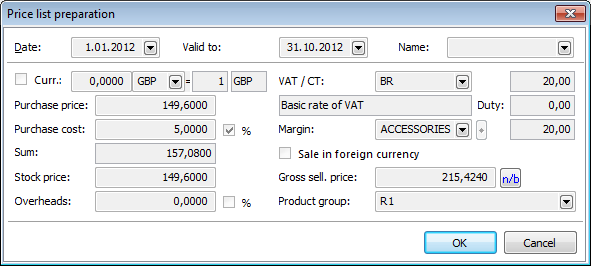
Picture: The date prices in the Price list preparation form - 5th page of an Article card
Except this entered interval the permanent price are valid that means the basic selling price and the prices derived from it, where the date is not defined (that means it is in " 0.0.0000", respectively "31.12.3000" format).
In order to automatically inserting date price to the items of a sales order and invoice out, you need in the Client parameters to check the field Use date prices of articles on-line.
It is methodologically recommended the data prices not to overlap. When evaluating a valid price the price will be found of which Date (date from) is the latest, also the price starting yesterday, takes precedence over price starting three days ago. It will be evaluated if this price is still valid (valid Date to). If this price is not valid yet, the common price will be used regardless if another date price exists still. Simultaneously if more prices that start in the same day exist, will be used.the price that is valid and ends soon. If none of these date prices are not valid, then the price where the end of the date is not entered at all will be used.
Example: The firm has defined the current price of the "Radishes" article (the date is in the "0.0.0000" format), and the price proceeds from an entered selling net price GBP 0.3234, the 14 % discount to the wholesale, the 8 % discount to the regular customers (The "Vegetables" product group).
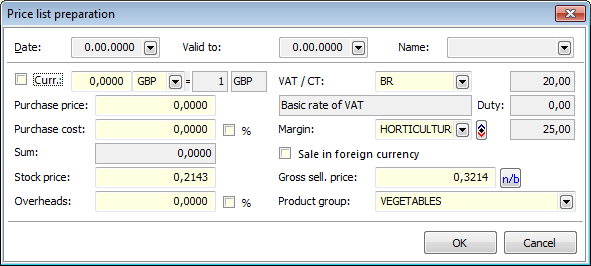
Picture: The Price list preparation form for a basic price
Further the date selling price that is valid from 1.7.2012 is defined for "Radishes". Its validity to is not defined. This date selling price is defined as the purchase price including purchase costs + 20 % of Margin, the 20 % discount to the wholesale, the 10 % discount to the regular customers. And the Purchase price is GBP 2.3 and it is necessary to add 10% of purchase costs.
Also the "Action" margin and the "Veg_action" product group are defined.

Picture: "Action" margin

Picture: "Veg_action" product group
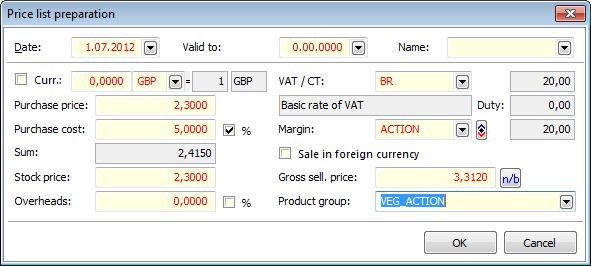
Picture: The Price list preparation form for date price valid from 1.7.2012
The company decided to organize the "Vitamin Week" at the start of the school year. The price of radishes will be reduced from 1.9.2012 to 7.9.2012 from an action price of regular customers and wholesalers by 20%. The action selling price, also "Action" margin will be used as a default.
Solution:
- Create a new product group "Action 09/2012" as a copy of the "Veg_Action" group where edit only the price for the regular customers.
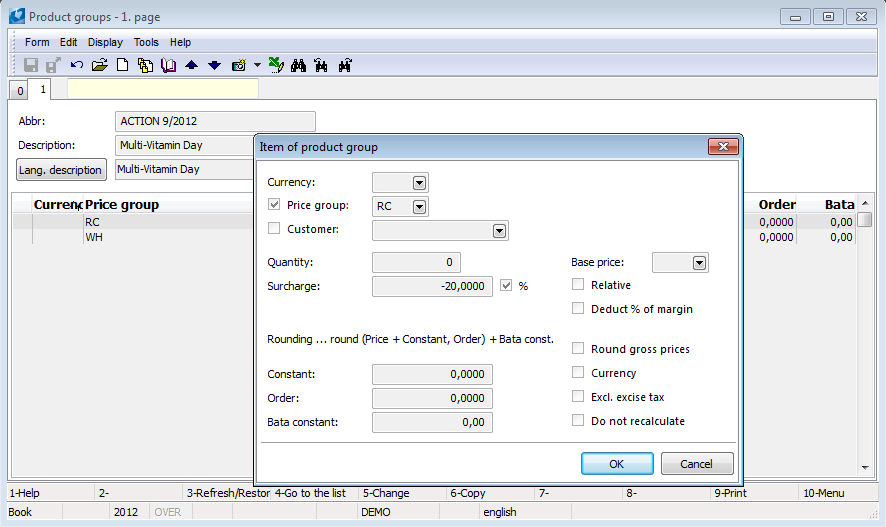
Picture: The Product group item "Action 09/2012" for the "Regular customers".
- Insert the data price validity from 1.9. to 7.9.2012 by pressing Ins key on the 5th page of the "Radishes" article card.
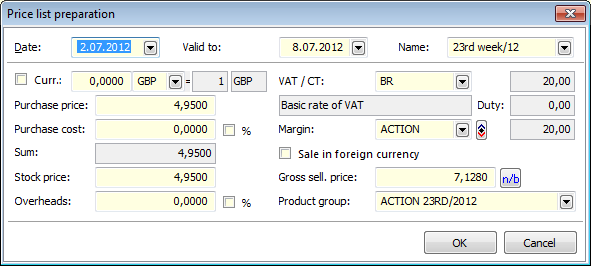
Picture: The Price list preparation form for date price valid from 2.7. to 8. 7.2012
- After pressing the OK button you will be asked if you want to recalculate the prices groups. Select Yes.
You have defined the action price for Radishes. This date price will be valid from 2. 7. to 8.7.2012 and the validity of the date price valid from 1.7.2012 will be temporarily interrupted.
Discounts
When selling you can grant one-time discount on the concrete selling item, or the selection or on each item in the document. You can enter an absolute or percentage discount. Always enter an absolute discount as unit. That means if you sell 5 pieces and you enter the discount 10CZK, the result discount on an item will be 50CZK.
You can enter the discount individually directly in the Selling item in the Pr. Reduct. field and eventually by checking the % field, or in bulk on more items by pressing the Change button that is accessible in the Change mode on the 2nd page of all selling documents. After pressing this button the form for the bulk change of data in the items will display. Check the Discount checkmark, insert the discount value and eventually check the % checkmark. You can select here too, whether you want to apply this change on a current item, on marked or unmarked or unfilled (i.e. still no discount) or all items. The change will be executed after pressing the OK button. The discount will display in the Pr. Reduct. field in the Selling item and in the S column too with the flag ![]() , eventually with the flag
, eventually with the flag ![]() , if it deals with a surcharge.
, if it deals with a surcharge.
The data for a discount you can enter in the Reduce item price field too next to the Change button, in that case it will be entered to the open form already.
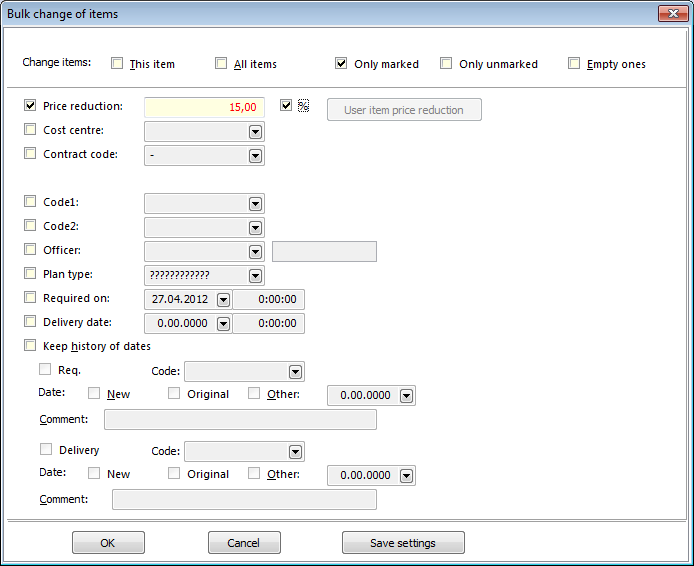
Picture: The Bulk change of items Form - entering a discount.
The further description of this form is stated in the K2 IS Basic guide in the Purchase/Sale item chapter.
The discount that is defined by this way can be highlighted (quantified separately) in the printed documents of the particular items.
Note: The User item price reduction button is in the form too. This button is activated if the special UsrReduction.pas script exists. This button enables to take into consideration the various specifics of the individual companies and users of the K2.
The discount is applied only on a sales order price or an invoice price. The possibility of applying discounts is followed by the same rules as the main manual editing the selling price in the Selling item. If the sales order price is not accessible (e. g. by confirmation of an inferior document), the price will be applied only on an invoice price and the F Price Only flag will be checked. In that case the sales order price will be distinguished from the invoice price. Re-enter discount does not load, but it rewrites. Thus, if you give the 10% discount and then you want to increase it to 15%, then you enter a final value in the Pr. Reduct. field, i.e. value "15".
To apply a regular discount for a customer, you can specify the discount rate on the 1st page of a Suppl./Cust. card in the Pr. Reduct. field. In this case, the value of a Suppl./Cust. card will display in the documents in the Change mode. Then the user can decide whether he applies the discount or not. Only the application of the discount (i.e. by pressing the Change button and then OK) is truly reflected in the prices of the documents.
The whole methodology can be used analogy in the purchase for marking a received discount, for example, if you want to separately quantify it.
Example: The company decided to provide 20 % discount on the just realized sales order (1000 pieces of large roses).
Solution:
Any preparation is not needed to grant the discount. You create a Sales order with the Large rose item on that you want to give a 20 % discount. You enter this Discount to the Pr. Reduct. field directly.
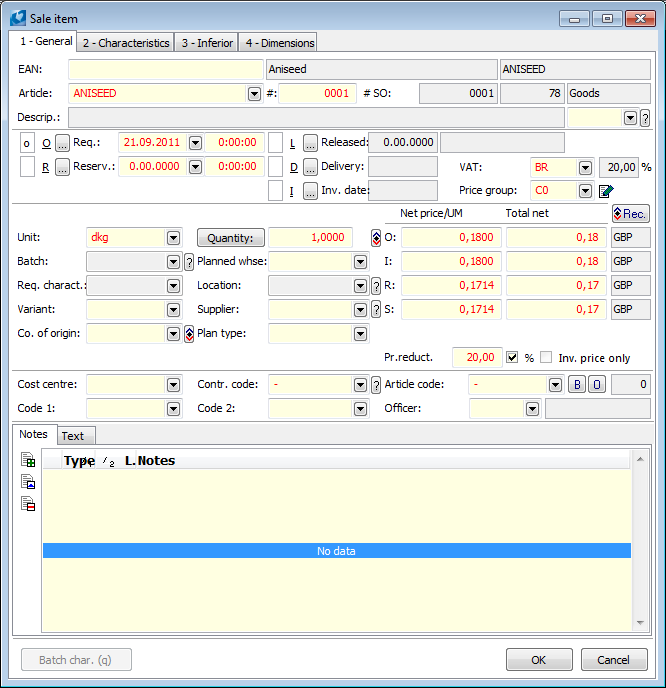
Picture: The Sale item form for the "Large rose" article
Continuation: The customer decided to extend this sales order - he wants to order 500 pieces of a Blue rose article too. Because he increases the sales order by this way, the company decided to increases the discount on all items to 25 %.
Solution:
In the sales order you create the 2nd item with an appropriate article. This time the discount will not been entered to the item directly, but you can use the possibility to correct the discount in bulk on all items.
Into the Reduce item price field you set the value 25 and check the % field. You press the Change button. The form with data that you have entered will display. Leave the All items option checked and press the OK button. The 25 % discount will be inserted into the all items of this document.
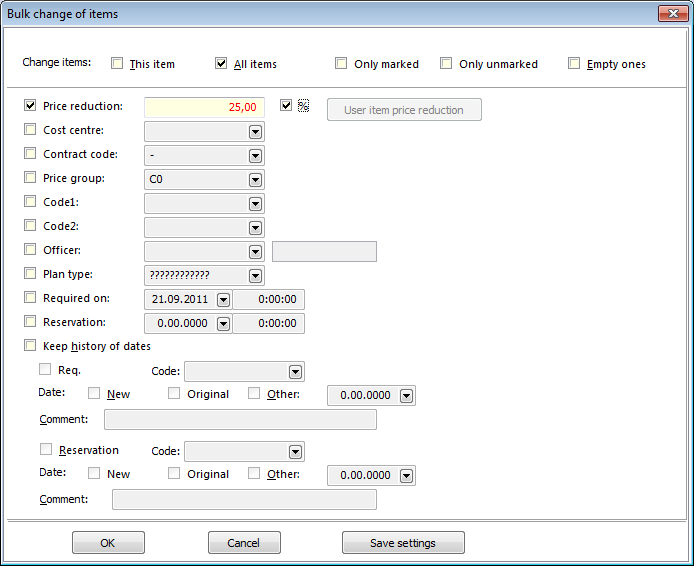
Picture: The Bulk change of items form
Prices recalculation
Prices recalculation enables to work with article prices in bulk. It is needed to authorize the Run price recalculations in Book of articles in the Administrator - General part.
It offers an update of the article prices that means of the purchase prices and the basic selling price, as well as the price groups and customer prices. It also allows you to create a date value based on the calculated values.
The function is activated on the one Article card (that means not on the page 0) or on the Article container from the module menu Actions - Recalculate article prices.
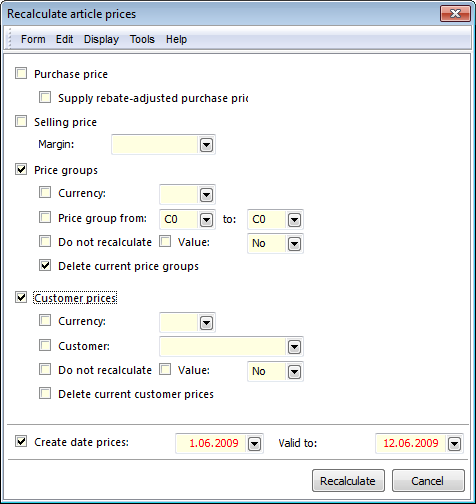
Picture: The Recalculate article prices form
Descriptions of the individual fields of the Recalculate article prices form are stated in the User Guide of the K2 IS.
It enables to recalculate customer prices of the one specific customer for all the Articles card in container. It is possible to change the method of the calculation of the customer prices by means of the recalculation (edit min. purch. quantity for this price - the Quantity field, the default price - the Base price field, percentage of a surcharge or discount - the Surcharge field).
The function is activated on the one Article card (that means not on the page 0) or on the Article container from the module menu Actions - Recalculate customer prices and it recalculates prices of the selected customer according to the defined parameters in the Recalculate customer prices form. These changes are reflected in the bottom part of the page 5 of the Article card, no into the Product groups.
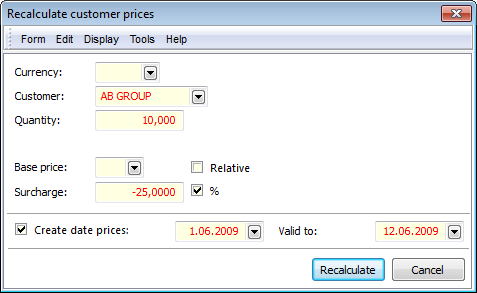
Picture: The Recalculate customer prices form
Descriptions of the individual fields of the Recalculate customer prices form are stated in the User Guide of the K2 IS.
It executes the change of prices of articles selected into the container. This change (percentage surcharge) is offered for Supplier Prices (according to the selected supplier), Purchase Price, Selling Price, Price Groups (it is possible to define an interval of price groups, which should be corrected), as well as Customer Prices (again for the selected customer).
The function is activated on the one Article card (that means not on the page 0) or on the Article container from the module menu Actions - Articles repricing. Also here it is possible to create the date prices. The prices can also be rounded according to a defined order and constant.
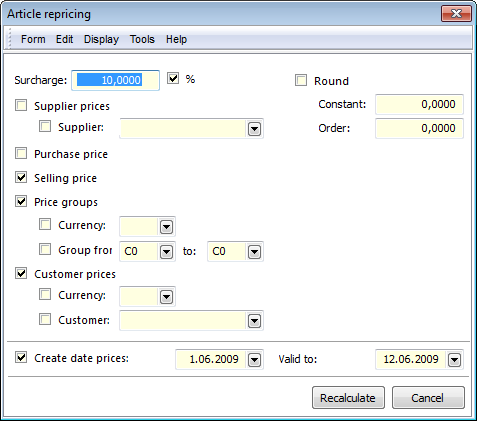
Picture: The Articles repricing form
If you run the recalculation by using the Recalculate button, the prices of the articles in container are recalculated and the articles will be removed from the container.
This function enables to change purchase and selling prices of each articles in container, prices of which are defined in the selected currency (article that uses the other currency for pricing, remains in the original prices).
The function is activated on the one Article card (that means not on the page 0) or on the Article container from the module menu Actions - Change exch. rate and recalculate prices.
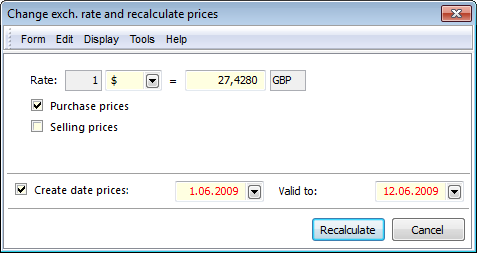
Picture: The Change exch. rate and recalculate prices form
By checking the Purchase prices or Selling prices fields, the function recalculates the prices in the basic currency according to the rate that is defined in the Change exch. rate and recalculate prices form. If these fields are not checked, only prices in the selected foreign currency will be recalculated.
The function is run from the module menu Form - Bulk actions - Change record on the Articles container or on the records indicated by asterisks. It serves to the bulk changes on the selected articles.
The fields important for pricing are stated on the 2nd page of the Bulk Change of Articles form.

Picture: The Bulk change of articles form - 2nd page
By checking the fields Currency and Exch. rate, prices according to the selected currency and exch. rate will be recalculated. You can choose whether the change relates to purchase or sales prices.
Note: Unlike the Change exch. rate and recalculate prices function, this function may also change a currency.
Further, it is possible to change all data, related with a price making, in bulk for the Article container, whereas a selling price will be edited after running the Recalculate article prices function.
For change of the actual prices to date prices, eventually for change of date prices to actual prices the Recalculate date prices function is used that you activate from the Action - Recalculate date prices from Module menu. This function serves for the change of the term of the date action (that means both dates of the action) too, or you can delete the date price that is valid in the defined interval.
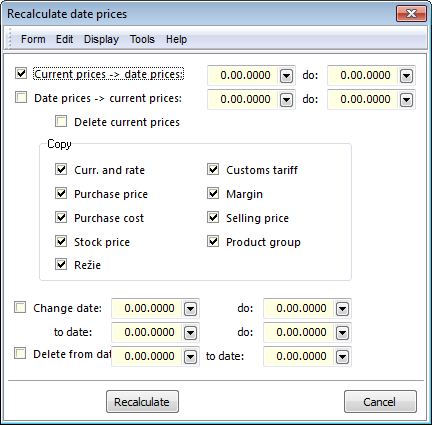
Picture: Recalculate date prices form
Descriptions of the individual fields of the Recalculate date prices form are stated in the K2 IS Basic guide.
Overview of parameters and selected fields that relate to the price creation of the K2 IS
This chapter involves the useful flags and parameters that can influence behaviour of the K2 in the price creation. It is not the complete list and simultaneously you cannot find here an exact description. For detailed studying use this methodology or User Guide of the K2 IS - the Basic modules, Purchase and Sale Shared Elements and Administration - User parameters and Client parameters section.
Purchase
User parameters
- Enter last price in purchase - prices of last purchase will be loaded into the purchase price
- Do not use supplier prices - the supplier prices will not be loaded from 5th page of Suppl./Cust. card in purchase, but only Purchase prices from 2nd page of Article card will be loaded.
- Suppress stock price in Reserving cards: the stock price will not be displayed in the reserving card.
Client parameters
- Stock price with secondary costs - it enables to involve secondary costs from an individual field into stock price of a purchased article.
Sale
Articles card
- Selling price acc. to batches - according to settings on a card, the identical flag will be filled on a batch.
- Customer prices in product group - it enables to count the selling price in the time of usage, it also enables to divide customer prices on the 7th page of the Suppl./Cust. card.
User parameters
- Show catalogue (price list) price - the K price is displayed in the Purchase item form. It is a value of a basic purchase price in the time of creation of the item.
- Do not display stock prices in sale - It suppresses the field with the S (stock) and R (reserving) prices in the Purchase item form. It is used in shops where the customer can look at the screen - it is not desirable to get noticed the stock prices.
- Do not use customer prices - the selling prices form 7th page of Suppl./Cust. card will not be loaded in sale, but only the prices from prices group will be loaded.
- Customer prices acc. to invoice address - enables to use the prices that are defined for customer who is entered in an invoice address. Attention - the Price group is not loaded, it is only dealt with customer prices.
- Price group on item from heading - each new item will have a price group that is to be set on a value from heading of document.
- Insert the resulting price group. - if any other price group is used as a Basic price for calculation of selected price group, this final price group from which the price is really counted will be entered in the item.
Client parameters
- Unsorted price groups of articles - it distinguishes which price group will be used as a substitute in case that the price is not defined for the entered price group.
Date prices
Client parameters
- Use data prices of articles on-line - it influences whether the date prices (purchase and selling) are considered as a preparation and they will be copied into the current prices at the right time or whether they are a part of definition and they should be automatically used if the current date corresponds with the term of validity of the date price.
Financing of E-waste collection - recycling fees
According to the amendment to the Waste Act, producers have been obliged to ensure the take-back, treatment and disposal of old electrical appliances since 13 August 2005. The cost of this system is to be covered by the recycling surcharge, which will be listed separately on the receipt for the purchased product.
In IS K2, information on the amount of the fee is given in the universal forms on the Article card in the Basic Data tab on the E-waste tab. Based on the entries in this tab and the registered function, an additional purchase/sale item with the enumerated recycling fee value will be automatically created for the item with an article requiring the recycling fee in the purchase documents (purchase orders) and the sales documents (sales orders).
Recycling fee registration works in IS K2 under the following conditions:
- The recycling fee per one product type is the same for each producer/seller, regardless of which company it is registered with (Rema, Retela, Elektrowin, Asekol, Ekolamp…).
- The surcharge is charged separately and so that it follows the item to which it belongs.
E-waste tab
Information on the existence and amount of the recycling fee is stated in universal forms on the Article card in the Basic Data on the E-waste tab. It is therefore necessary to insert a record representing the waste on the E-waste tab on the article card (electrical appliances).
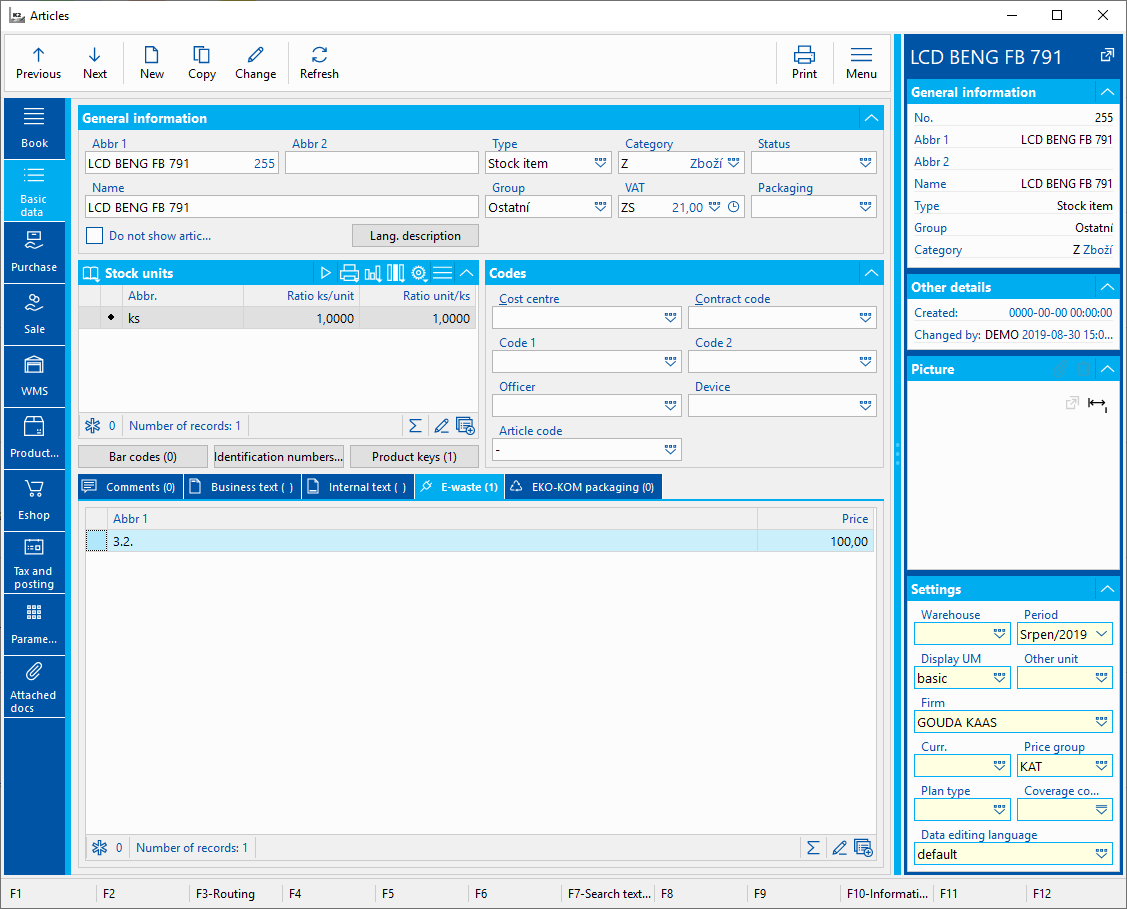
Picture: The E-waste tab on the Article card
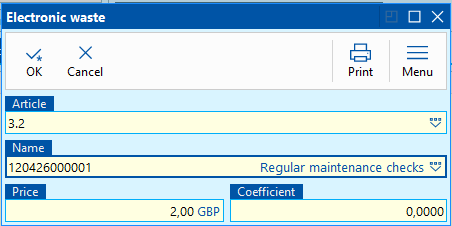
Picture: The E-waste form
Fields' Description:
Abbr 1 |
The article card of non-stock items type, it has a 21% VAT rate, the E-waste brand and further in abbreviation it carries information about the group of electrical equipment that it represents. The following pictures show how these cards can look like. (It is not necessary to follow the proposed structure of the abbreviation, as well the cards could be named EO_3.1, EO_3.2, EO_3.3, ...). This field is obligatory. |
Additional name |
If we select only one card for the group (in the example, these are cards 3.1 to 3.6), then it is possible to specify the item on the invoice by means of an additional name. (Or you can choose the way, as cards 3.7_1 and 3.7_2, when the card carries detailed information about what type of electrical appliance it belongs to, and the additional name is then unnecessary.) It is also possible to choose the path of a single article card (non-stock items type) and then insert it into the document items. However, this can cause reporting problems, when it is necessary to report the sum of the groups specified in Annex No. 7 of the Act. |
Price |
Recycling fee in Czech crowns, price excl. VAT. If the price is not specified, then the script inserts in the sale the selling price of the article card listed in the Abbreviation 1 field. In the Purchase, the price entered in the Purchase price field of the article listed in the Abbreviation 1 field is inserted. |
Coefficient |
Multiplier of a fee (e.g. for a luminaire that has 3 bulbs). If it is blank (0 is displayed), it does not enter into the calculation. |
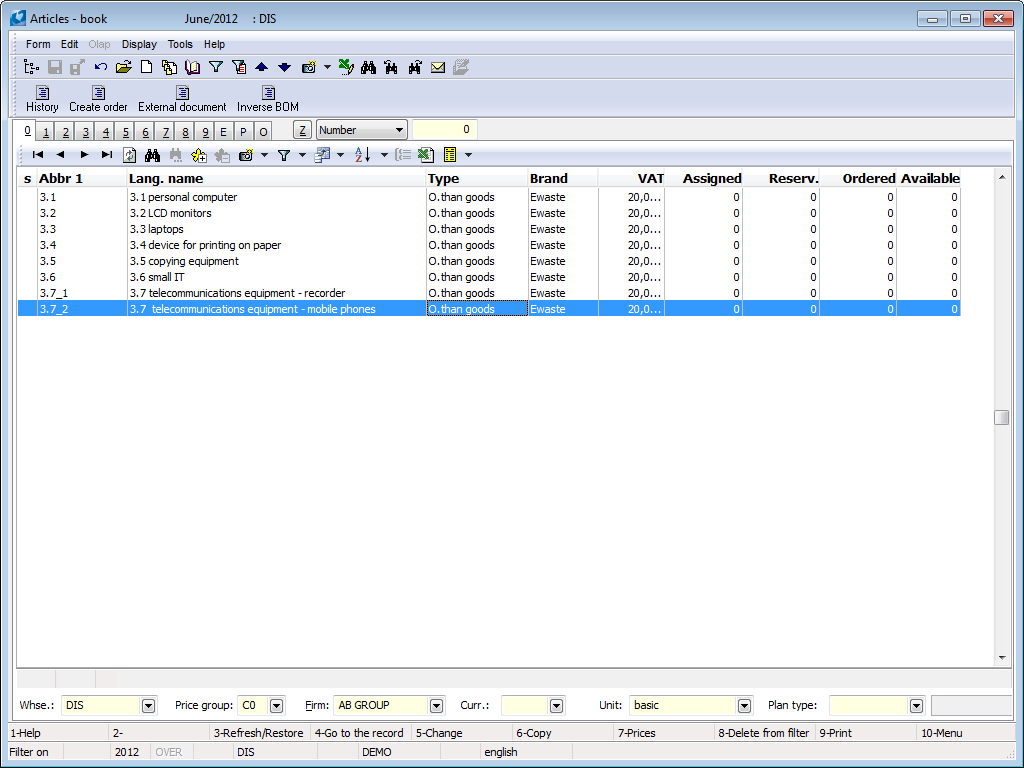
Picture: Demonstration of cards for recording recycling fees
Bulk adding/editing of the E-waste records
To facilitate insertion of E-waste record onto the Article cards, the Bulk adding/editing of the E-waste script was created (the technical details are stated below).
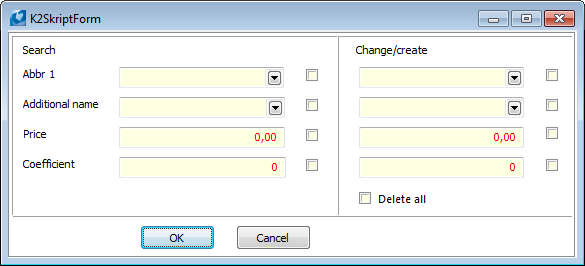
Picture: The form for a bulk insertion, change or deleting E-waste record
1. Bulk creation of records:
In the Article container, fill in the right part of the form. Define the field values and activate it by ticking.
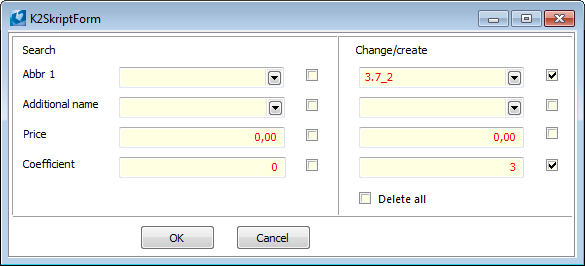
Picture: Using the script for a bulk insertion of E-waste records
2. Bulk change:
Fill in and activate a selection criterion in the left part of the form, then activate fields that should be changed by the filled value in the right part. If you run the script in the Articles book (in the 'Book' mode), then all the article cards, that contain the E-waste record complying the left part of the form, will be inserted into container and they will be changed according to the definition in the right part of the form. If the script runs on the container of articles, then only those records from the filter, that correspond to the left side of the form, will be changed. Values are changed according to the right part of the form.

Picture: Using the script for a bulk change of E-waste records
3. Search and filter:
If you run the script in the Articles book in the 'Book' mode and you use only the left part of the form, then all the article cards, that contain the E-waste record complying the left part of the form, will be inserted into container.

Picture: Using a script to search for E-waste records
4. Delete all E-waste records:
The Delete all field works only in the Container mode. It removes all the E-waste records from the articles cards in container.

Picture: Using a script to delete E-waste records
Adding a fee to a sales order
Adding the fees to sales orders is ensured by a registered function that runs the script Adding fee to sales order - E-waste. The script can be run separately without registered function. The technical details are stated below.
If a sales order is in change mode, the registered function in the sales order book adds an additional sales item (or items, if there are multiple entries) to all new sales items, article cards of which have record in E-waste. The article, specified in the E-waste record, with price and name will be added. The price shall be multiplied by the coefficient and the quantity sold, taking into account also sales in alternative units. However, the charge is given for the quantity in the base unit. If the price in the E-waste record is zero, the selling price from the E-waste card is taken.
If the item of the type Stock item is on an UNCONFIRMED invoice, then the created fee will be inserted on the same invoice.
Example:
- First create the sales order in the standard way.
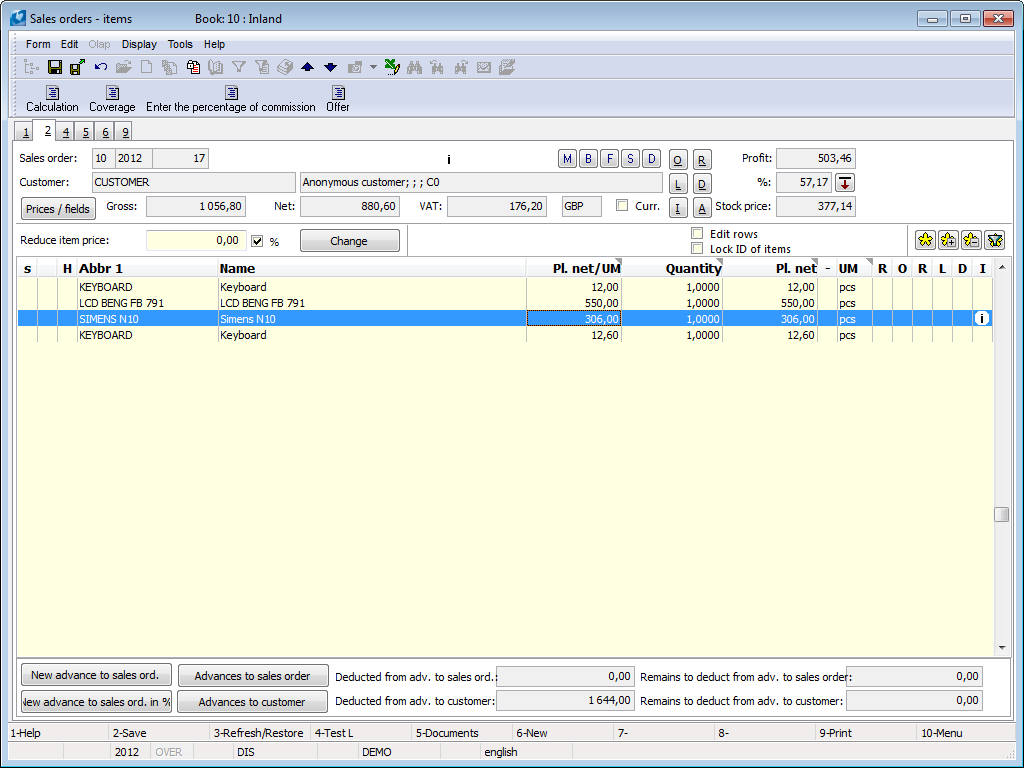
Picture: The Sales order created in the standard way
- Once saved, the registered function will ensure the creation of appropriate fees on the sales order.
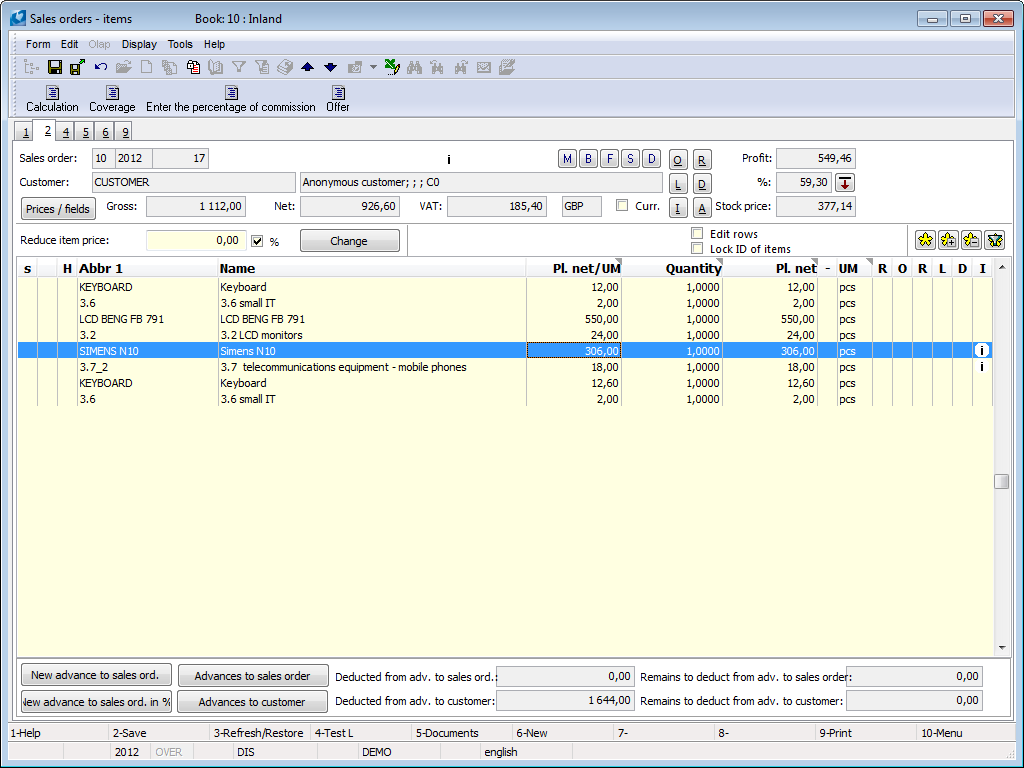
Picture: The Sales order after saving
Sales order's items:
- Water - the article card has no record in E-waste, therefore it has no fee
- Keyboard - 1 pc - 16 CZK fee
- Keyboard - 1 package - a charge 4x16 CZK because the package includes 4 pieces
- The Siemens C55 was on an unconfirmed invoice, so the fee was also inserted on the same invoice
If the fee is deleted after saving the order, the registered function will not complete it (E-waste is added to new items only). If you change the sold quantity, the amount of fees does not change. This change must be handled by the user. After inserting fees on sales order, these fees are not checked any more.
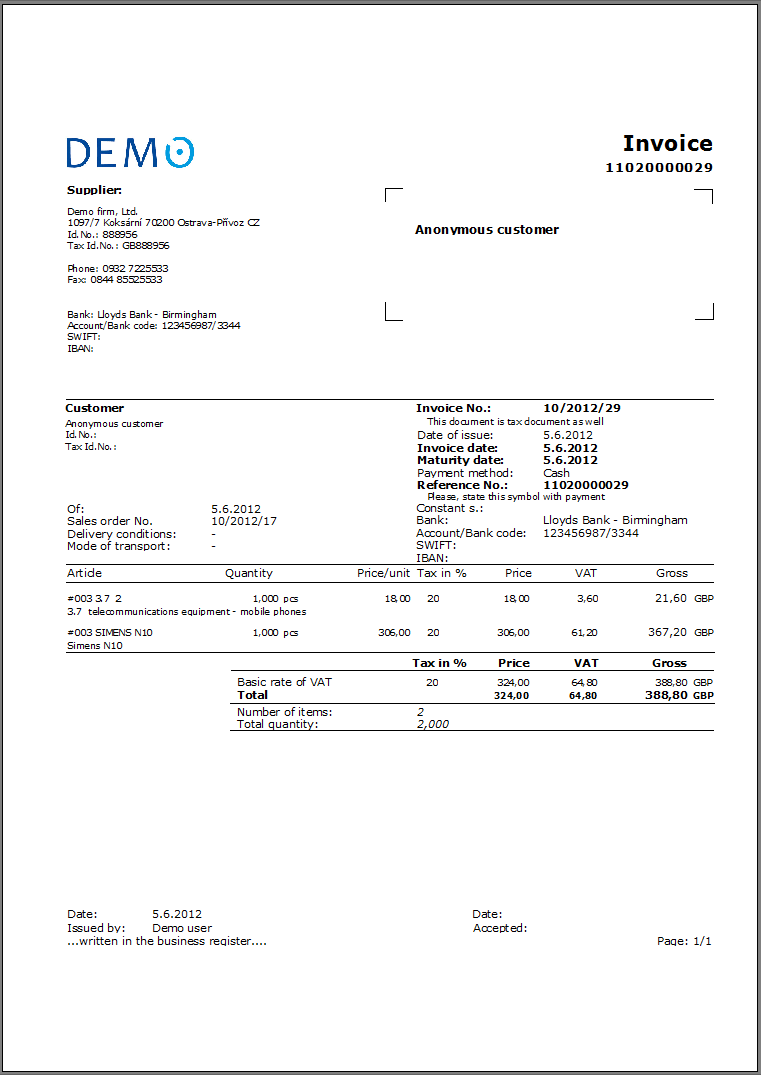
Picture: Print of the invoice out including a fee
Adding a fee to a Purchase order
Adding the fees to purchase orders is ensured by a registered function that runs the script Adding fee to purchase orders - E-waste. The functionality in the Purchase module is the same as in the Sales module. The script can be also run separately without registered function. Technical details are listed below.
The next setting
Correction of the already created fees:
Because of the fact that the registered functions create fees for the electrical waste only to the new items and do not take into consideration the additional changes of quantity, the script "The change of fee for a sales order/order - electrical waste" was created. If the user is on the 2nd page of a sales order (order) and the document is not in the Change mode, then the items of the electrical waste that are not placed in the inferior documents, or they are in unconfirmed inferior documents, will be deleted and created again.
Account Distribution:
It is possible to set in, the U_RegGlobalVarEO.pas unit, it is possible to find the unit specimen in the directory K2\REPORTSW\STANDARD\K2R (K2\SESTAVYW\STANDARD\K2R) with the XU_RegGlobalVarEO.pas name. This unit will be copied into the K2\REPORTSW\STANDARD (K2\SESTAVYW\STANDARD) directory with the U_RegGlobalVarEO.pas name and the rows with the constants for the account distribution of purchase and sale documents will be filled. The account distribution that are identified with theirs ID (unique number) will be automatically entered into the sale (purchase) items when this setting.
|
Kontace_EO_ZAK = 0; (Account distribution_EO_SALORD = 0;) |
|
Kontace_EO_OBV = 0; (Account distribution_EO_ORDER = 0;) |
Limitation of fees creation in the purchase or sale books:
The fees may not been inserted into documents of purchase and sale in all books (series), creating can be suppressed in certain books. This can be set in the U_RegGlobalVarEO.pas unit by the similar way as the account distribution.
|
Rada_EO_ZAK = ''; (Serie_EO_SALORD = '';) //the books where the fees do not have been inserted |
|
Rada_EO_OBV = ''; (Serie_EO_ORDER = '';) //separate the books by semicolons, e. g. '10;20' |
Technical information
File list:
- Scripts: Pozn_Elektroodpad.pas, Vloz_EO_Zak.pas, Vloz_EO_Obv.pas, EO_Updata.pas, XU_RegGlobalVarEO.pas
- Forms: F_Elektroodpad.dfm
The registered functions:
- Form:
- RFSAdd('Vloz_EO_Zak.PAS', False, 102, 2, 0, 3); // After saving on the form ZAK
- RFSAdd('Vloz_EO_Obv.PAS', False, 85, 2, 0, 3); //After saving on the form OBV
- Date:
- RDSAdd ('Vloz_EO_Zak.PAS', false, DmIdToNum('TD_Zak'), 2, 0, 3); //After saving after start of the transactions in the ZAK data module
- RDSAdd ('Vloz_EO_Obv.PAS', false, DmIdToNum('TD_Obv'), 2, 0, 3); // After saving after start of the transactions in the OBV data module